Lufthansa’s Allegris business class: a revolution in the skies, or a gamble? Your seat assignment will determine if you’re soaring in unparalleled luxury or stuck in upgraded purgatory. Choose wisely, traveler. Your dream flight hangs in the balance.
Pros
- An incredible array of seat options, including ultraprivate suites.
- Decent seasonal menus with dishes you can order ahead of time.
- Excellent tech, including full-size tablets to control seat functions and entertainment.
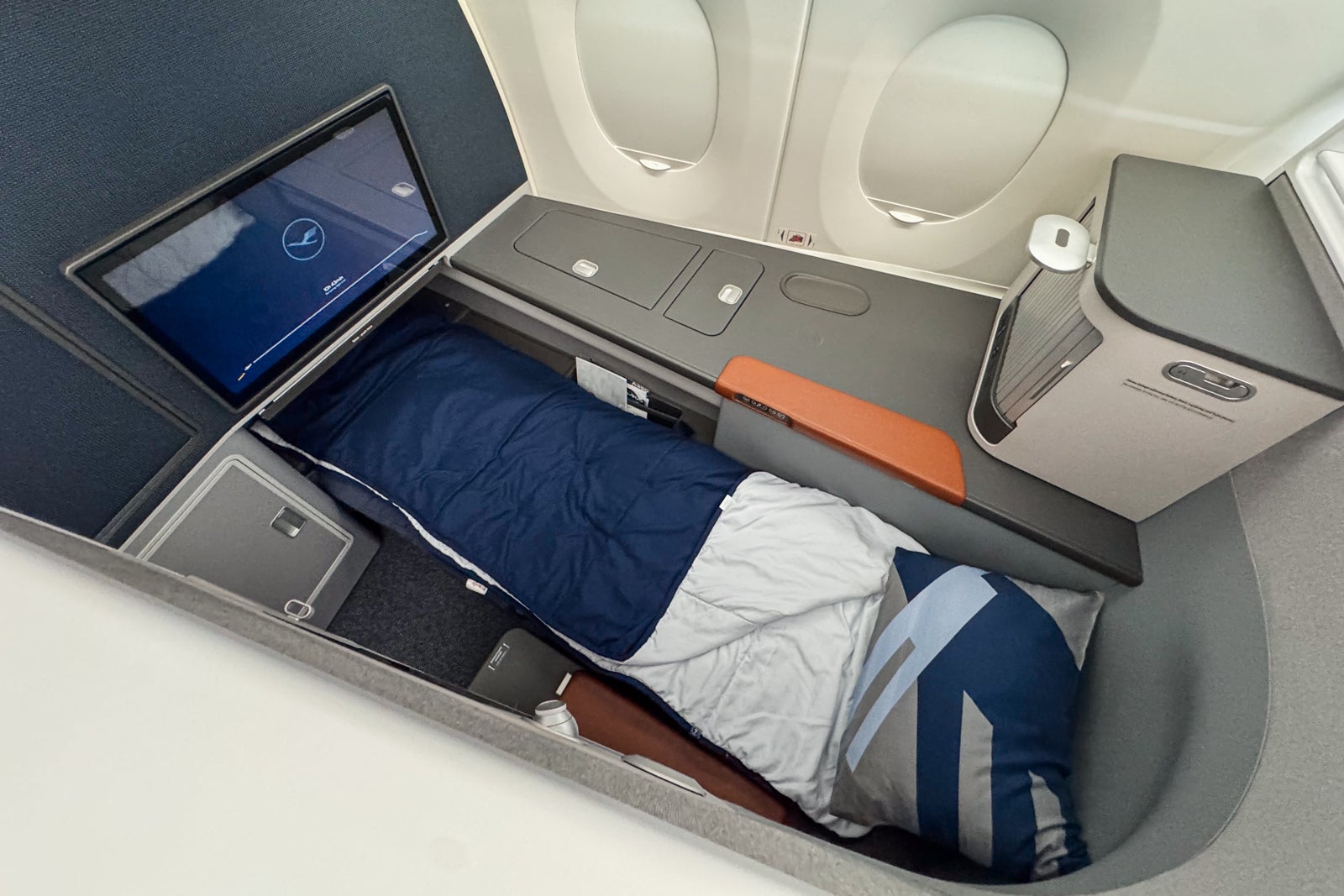
ERIC ROSEN/THE POINTS GUY
Cons
- Five different seat types, and having to pay for most of them, are likely to put off some travelers.
- It can be difficult to keep track of which routes this product is available on.
- Award availability exists, but it is spotty and can involve some high taxes and fees.
Lufthansa’s Allegris business class: a concept teased in 2017, finally gracing the skies in 2024. Seven years. That’s not anticipation; it’s an archaeological dig for comfort. Passengers weren’t just waiting; they were practically fossilizing with excitement.
Touching down in May 2024, TPG experienced Lufthansa’s Allegris business class firsthand on its inaugural flight. Now, Lufthansa is progressively transforming its long-haul experience, one luxurious Allegris seat at a time.
Last month, we cashed in some miles for a coveted award ticket, jetting from Munich (the airline’s heartland) to sunny San Diego. Our mission? To put their premium cabin to the test and uncover insider tips for navigating the experience, especially with their five distinct seat types.
Here’s everything you need to know about Lufthansa’s Allegris business class and how to book it using points and miles.
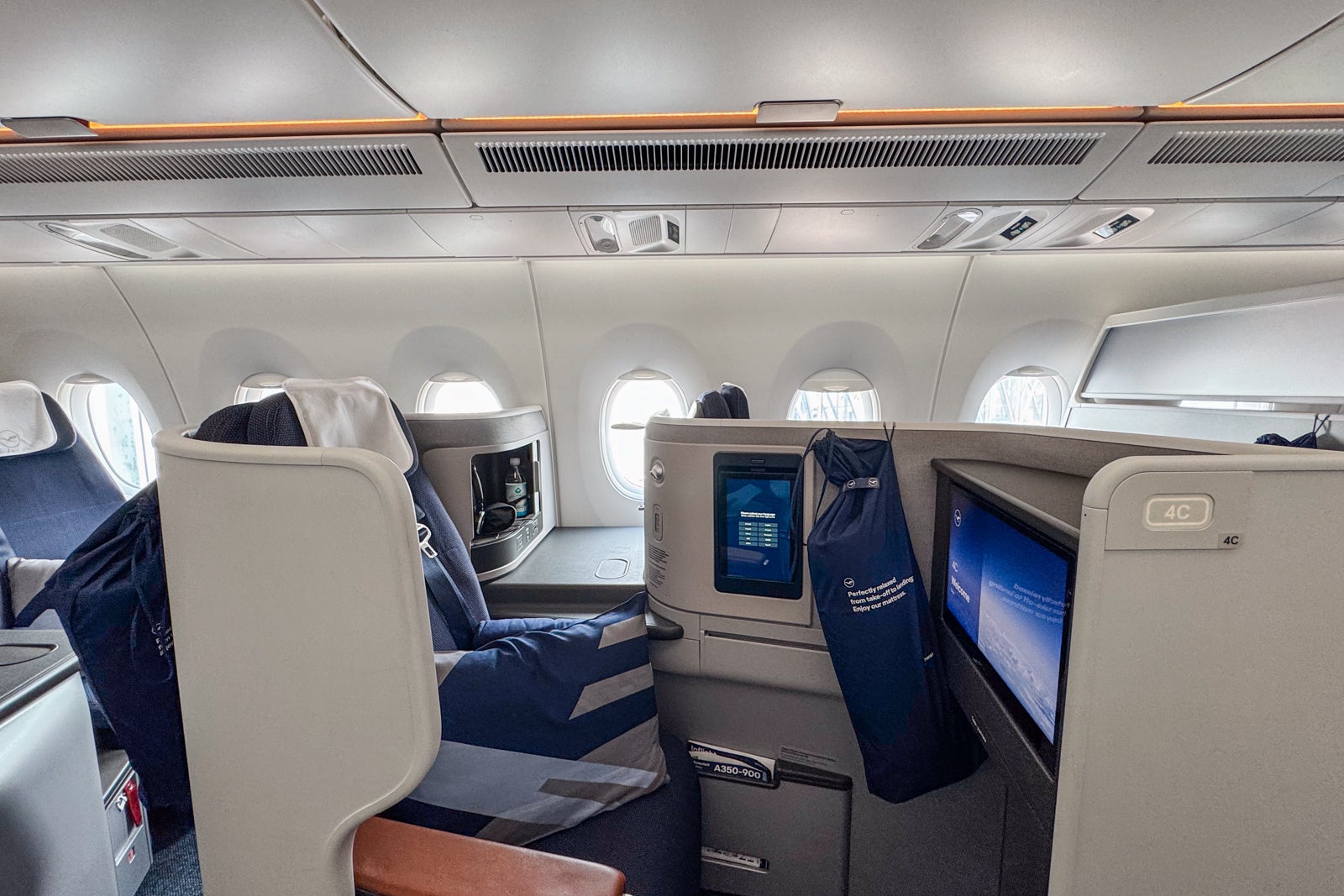
ERIC ROSEN/THE POINTS GUY
How much does it cost to book Lufthansa business class?
Dreaming of stretching out in a Lufthansa business class seat? Be prepared – the price of that luxurious experience is a moving target. Your departure city, final destination, and chosen travel dates all play a crucial role in determining the final fare.
Lufthansa’s coveted Allegris first and business class seats are currently a rare treat, gracing only select Airbus A350-900s. But the future promises wider access to sky-high luxury, with plans to roll them out across Boeing 747-8s and certain 787-9 Dreamliners. Prepare for an elevated journey.
Currently, you can experience Allegris firsthand, taking flight from Lufthansa’s Munich Airport (MUC) hub to these destinations:
- Kempegowda International Airport Bengaluru (BLR)
- Charlotte Douglas International Airport (CLT)
- O’Hare International Airport (ORD)
- Newark Liberty International Airport (EWR)
- San Diego International Airport (SAN)
- San Francisco International Airport (SFO)
- Shanghai Pudong International Airport (PVG)
Flyers can expect to see additional destinations like Cape Town and Tokyo come online in late October.
Swapping pretzels for Pacific sunsets doesn’t come cheap. Flying from Munich to San Diego will run you roughly $4,088 for a round-trip ticket if you’re starting your journey in Europe. Thinking of heading back Stateside? Prepare to shell out a steeper $7,257.
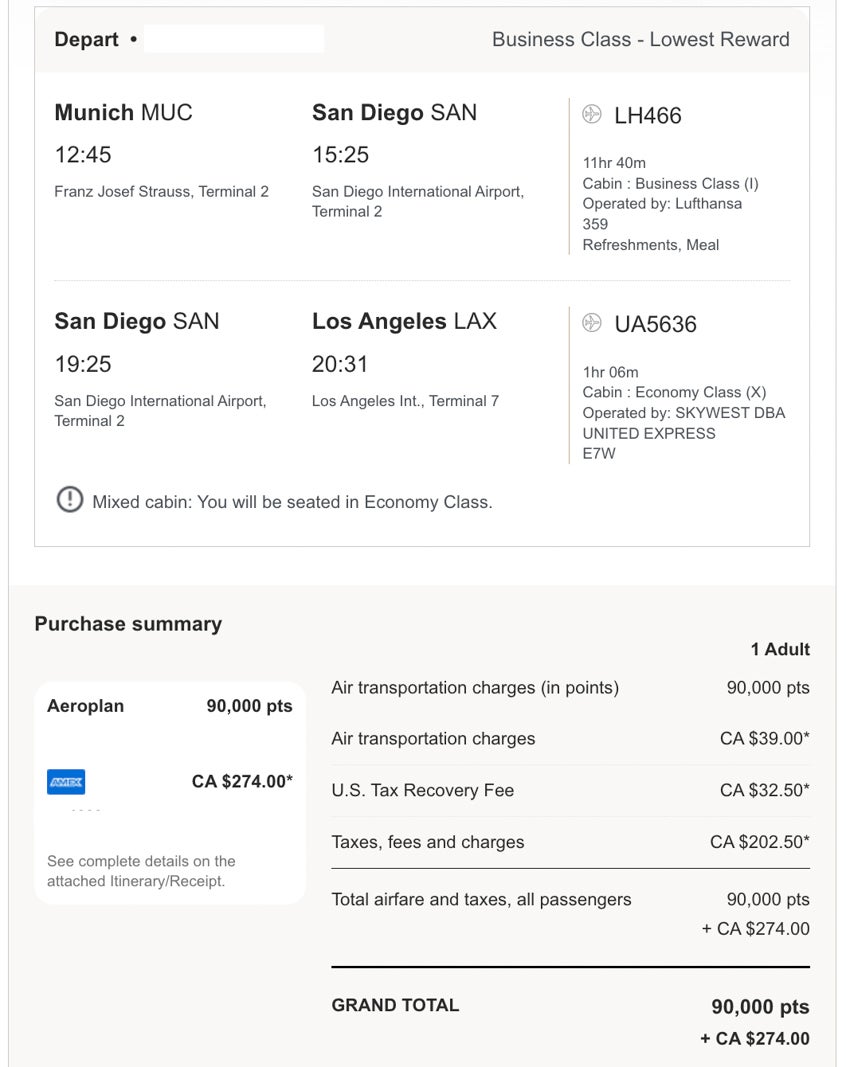
AIR CANADA
Lufthansa unlocks a world of travel. As a Star Alliance member, your points aren’t confined to Miles & More. Imagine using United MileagePlus miles or Air Canada Aeroplan points to snag that Lufthansa dream flight!
Aeroplan is a transfer partner of:
- American Express Membership Rewards
- Bilt Rewards
- Capital One
- Chase Ultimate Rewards
- Marriott Bonvoy (3:1 with a 5,000-point bonus for transferring 60,000 points)
United MileagePlus is a transfer partner of Bilt and Chase.
Unlock your next adventure! Fly this route for just 90,000 Aeroplan points (plus $5.60-$200 in fees, varying by direction) or snag it for 88,000 United Airlines miles and even lower taxes.
| Program | Mileage cost one-way |
|---|---|
| Aeroplan | 90,000 miles plus $5.60-$200 |
| American Airlines AAdvantage | 88,000 miles plus $5.60-$140 |
Hunting for Lufthansa’s elusive Allegris seats? Forget booking blind! Your secret weapon: the seat map. Spot a staggered layout with coveted single seats flanking the aisles? Jackpot! You’ve found an Allegris-equipped bird. See rows of 2-2-2 seating instead? Prepare for a classic (but less cutting-edge) Lufthansa experience. Happy hunting!
Snagged your tickets? Awesome! Now, brace yourself for the seat selection game. Your free choices? A slim pickin’ of “Classic” seats. Want a fancy perch? Prepare to shell out we’re talking anywhere from $185 to a whopping $650 for those specialty spots. (More on those luxe locales in a sec!).
Checking in to and boarding Lufthansa business class
Lufthansa business-class passengers can enjoy the following priority services at the airport.

ERIC ROSEN/THE POINTS GUY
| Priority check-in? | Yes |
|---|---|
| Luggage allowance | Two checked bags of up to 32 kilograms (70 pounds) each |
| Lounge access? | Yes, Lufthansa business-class and Star Alliance partner lounges |
| Does the airline participate in TSA PreCheck? | Yes |
| Priority boarding? | Yes, after preboarding |
Munich’s airport unfolded like a dream. Two hours until takeoff, yet the business-class check-in was a ghost town – pure bliss. Bag vanished, security surrendered in a blink, and then, the real prize: Lufthansa’s business-class lounge, accessible only by a secret underground train. The anticipation hummed with each passing meter.
Previous slide


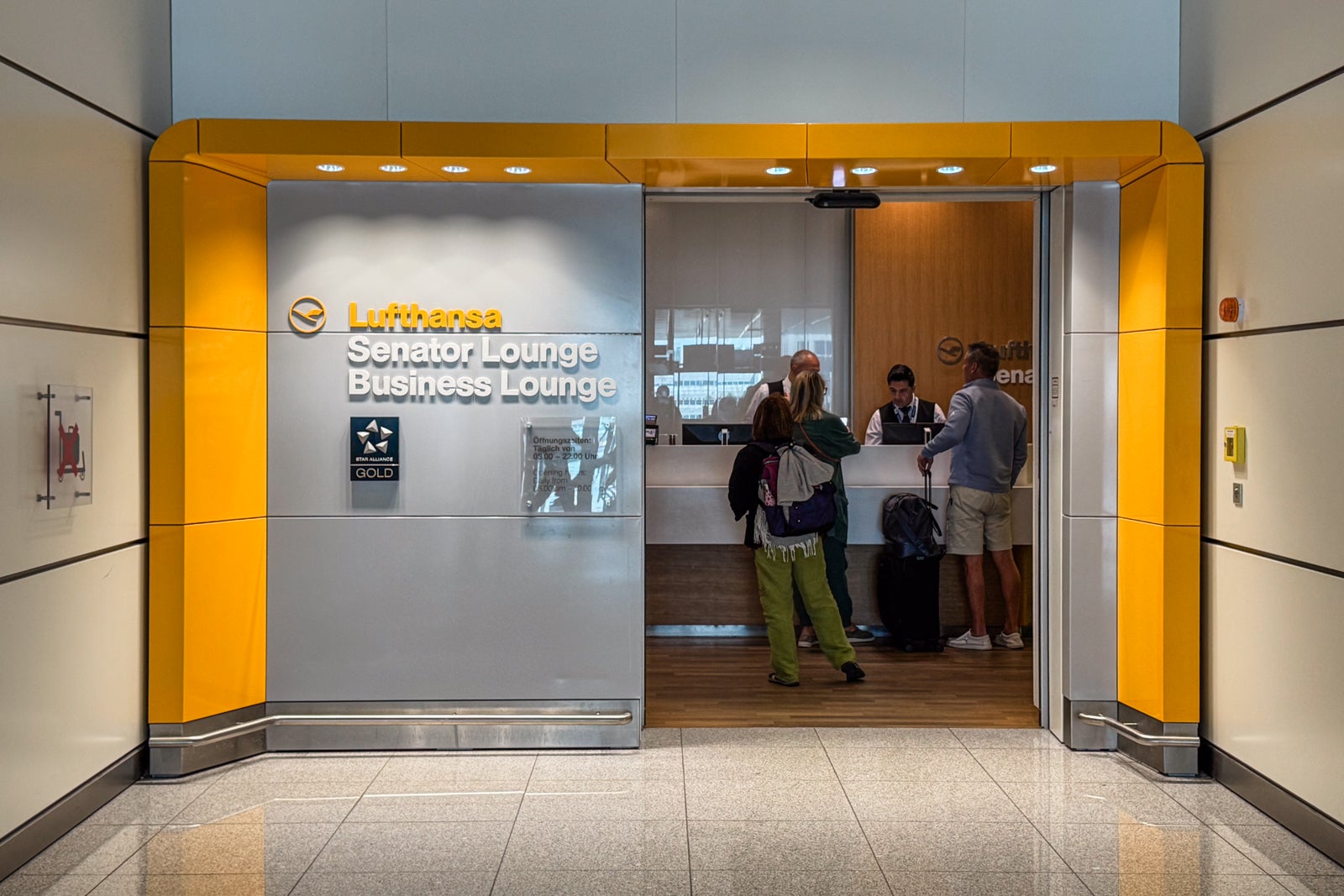



Next slide
1 of 6
ERIC ROSEN/THE POINTS GUY
0
1
2
3
4
5
With the clock ticking down to departure, I joined the eager throng pushing towards the gate, all vying for that coveted spot at the head of the boarding line.
Lufthansa Allegris business-class cabin
Forget brochures and glossy photos. Lufthansa Allegris business class on the A350-900? It’s an experience that truly clicks only when you’re settled into its embrace, soaring above the clouds.
The mystery of seating: solved! Forget basic “seats.” We’re diving into a realm where thrones clash with cushions, and buckets battle benches. Depending on how you slice it, you’re looking at five to seven distinct seat species. Our count? A definitive five.

ERIC ROSEN/THE POINTS GUY
Here’s a quick snapshot of the cabin and its specifications.
| Number of seats | 38 |
|---|---|
| Cabin layout | 1-2-1; 1-1-1 |
| Seat recline | 75-86 inches, fully flat |
| Seat width | 22 inches |
| Screen size | 18-24 inches |
Forget claustrophobic cabins. Lufthansa’s Allegris business class boasts 38 suites across two zones, promising a personalized experience. The cabin’s layout dances between a spacious 1-2-1 and an exclusive 1-1-1 configuration, a testament to the variety of bespoke seating options awaiting you.
The front section has 20 seats, and the back section behind the galley and two lavatories contains the remaining 18.
The cabin looks pretty sharp thanks to the predominantly blue, white and silver color palette clean-looking and elegant.

ERIC ROSEN/THE POINTS GUY
Lufthansa Allegris business class: 5 seat types
Here’s where Lufthansa Allegris business class gets interesting… or perhaps a bit perplexing. Brace yourself: there aren’t just one or two seat options, but a whopping five! And be warned, snagging your preferred spot likely comes with a price tag.
Here’s the number of each seat type and the cost to select them for my flight.
- 12 Classic seats (closer to the aisle): $0
- 10 Privacy seats (closer to the window): $185
- 4 Extra Long Bed seats (closer to the aisle but more legroom): $185
- 4 Extra Space seats (in the middle but with no neighbors): $250
- 8 Business Suites (first row of each cabin with extra room and closing doors): $650
It’s a whirlwind, isn’t it? Especially trying to decipher the seating chart without ever having set foot on board.
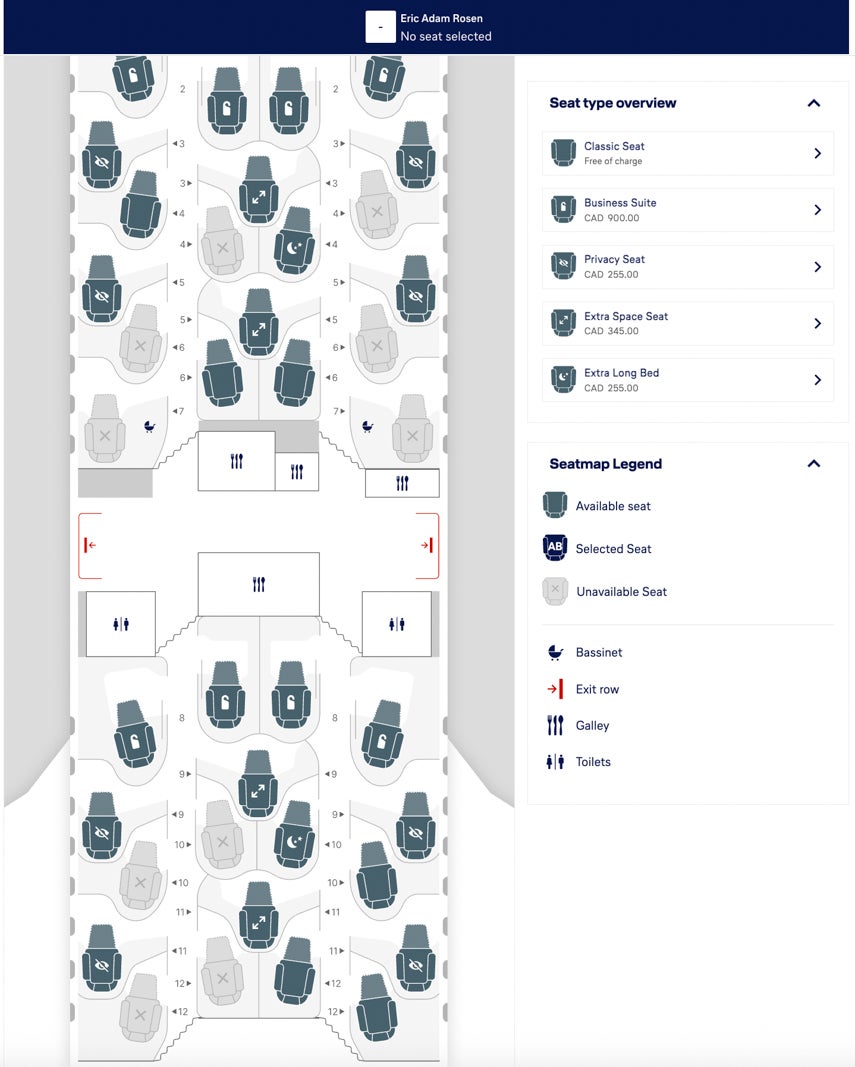
LUFTHANSA
Think of the Classic and Extra Long Bed seats as twins, nearly identical! The only difference? Extra Long boasts a few more precious inches, perfect for stretching out those legs.
Previous slide
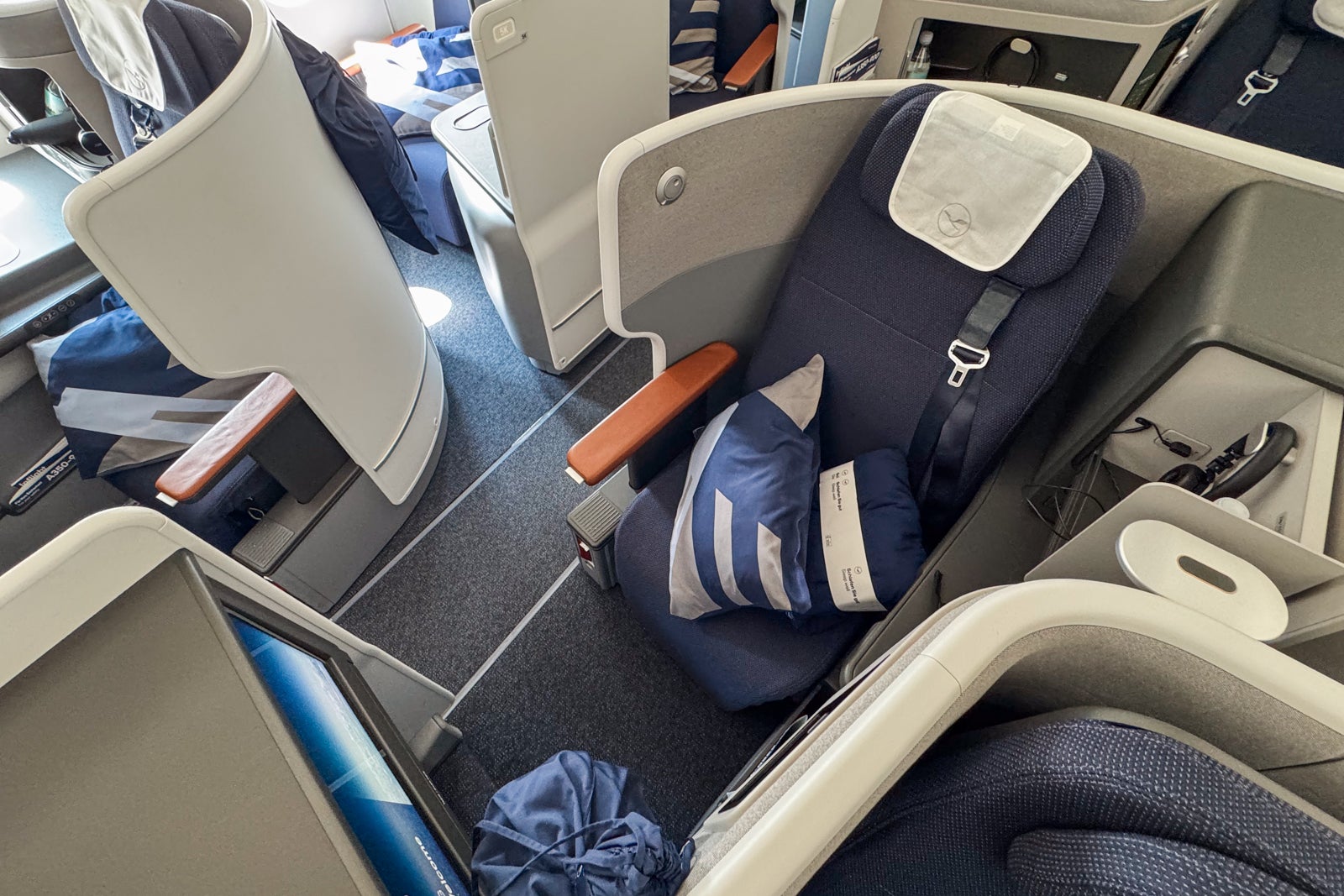

Next slide
1 of 2
ERIC ROSEN/THE POINTS GUY
0
1
The Privacy seats are window seats with a long armrest and a privacy shield from the aisle.
Previous slide

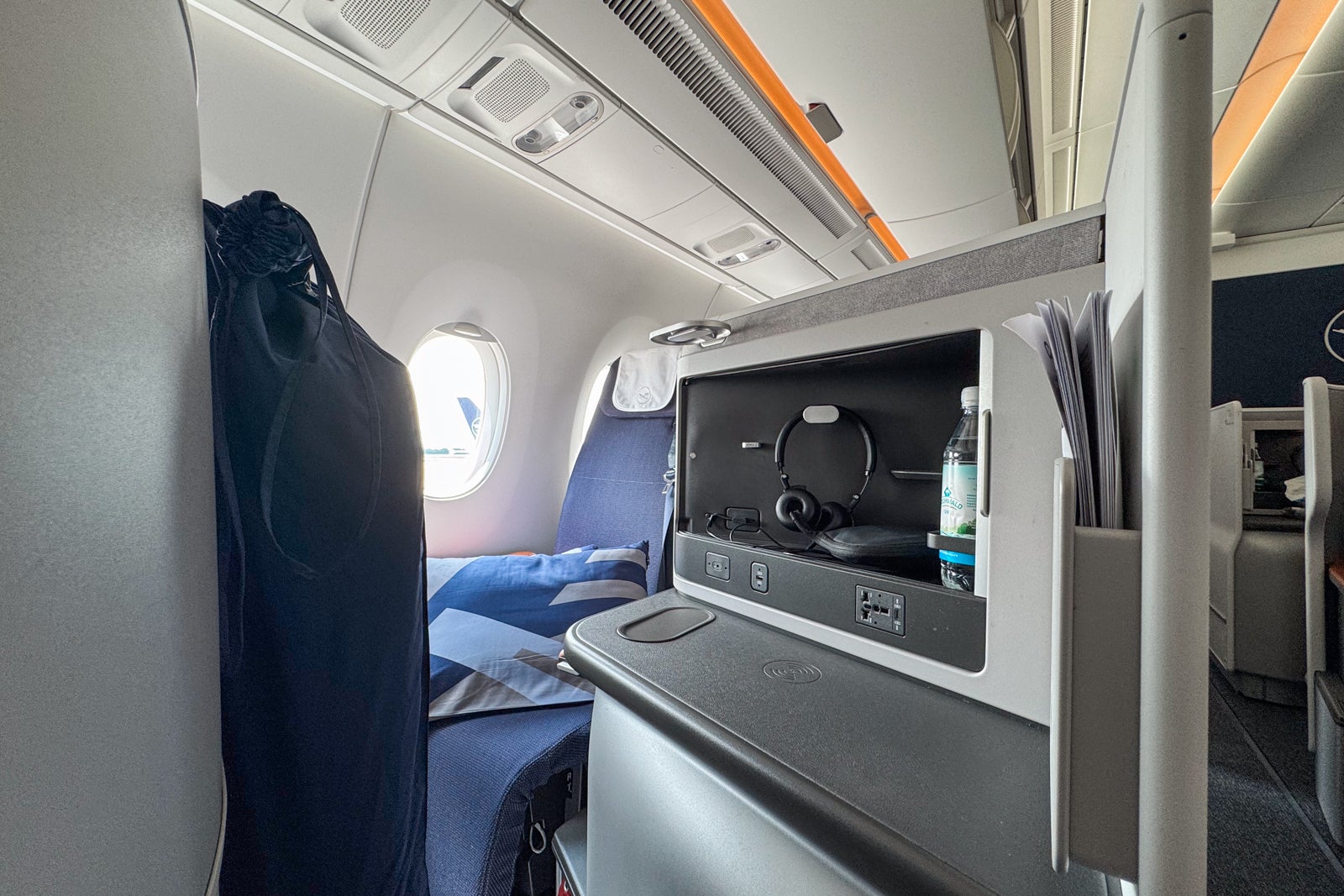
Next slide
1 of 2
ERIC ROSEN/THE POINTS GUY
0
1
The Extra Space seats are middle seats with no immediate neighbors and high privacy partitions.
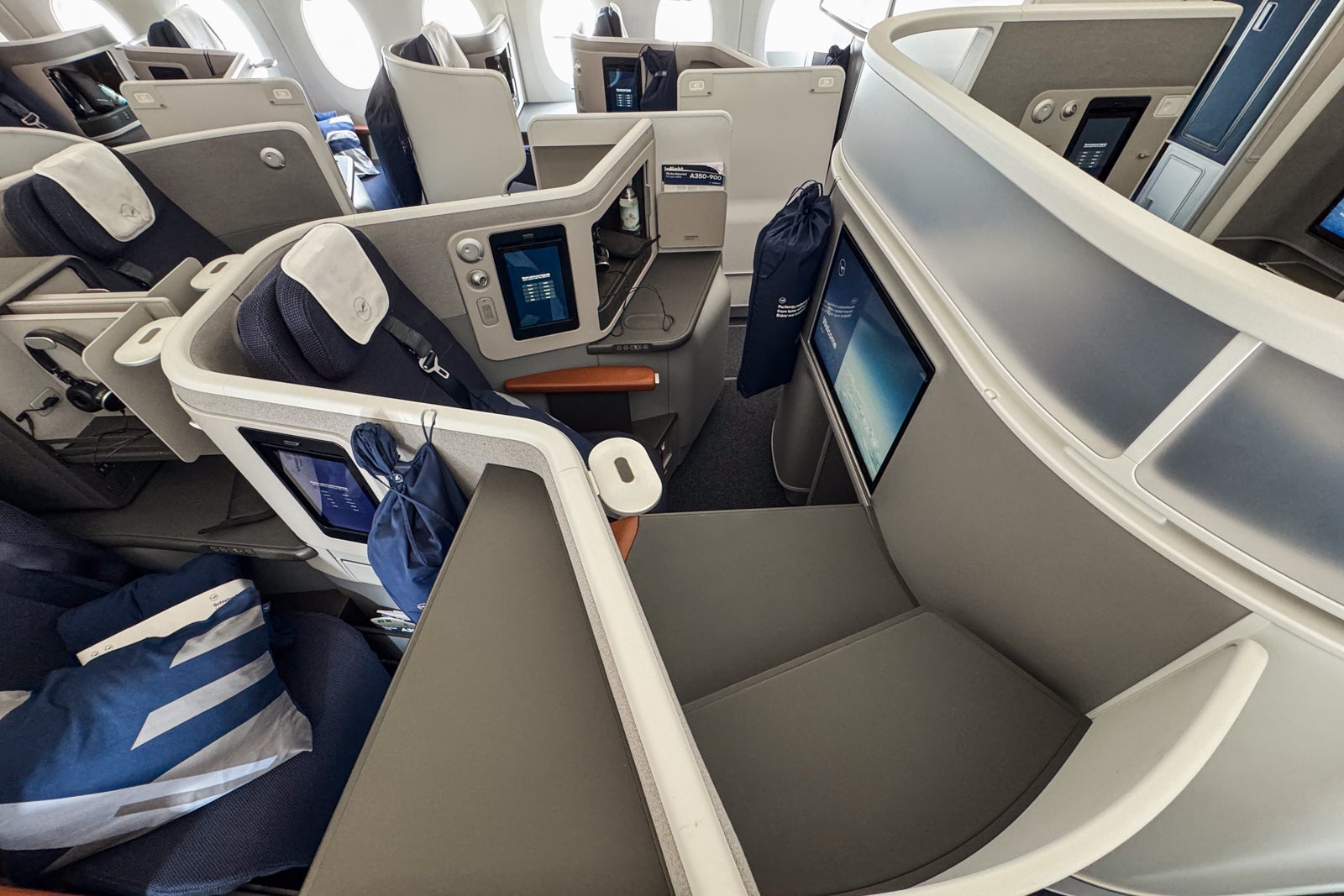
ERIC ROSEN/THE POINTS GUY
Forget cramped quarters and flimsy dividers. The Business Suites aren’t just a step up; they’re a leap into a new echelon of travel. Imagine: closing privacy doors transforming your space into a personal sanctuary. Picture this: soaring shell heights offering unparalleled tranquility. And feast your eyes on entertainment screens that dwarf their business-class counterparts. This isn’t just business class; it’s business elevated, where added amenities transform a flight into an experience.
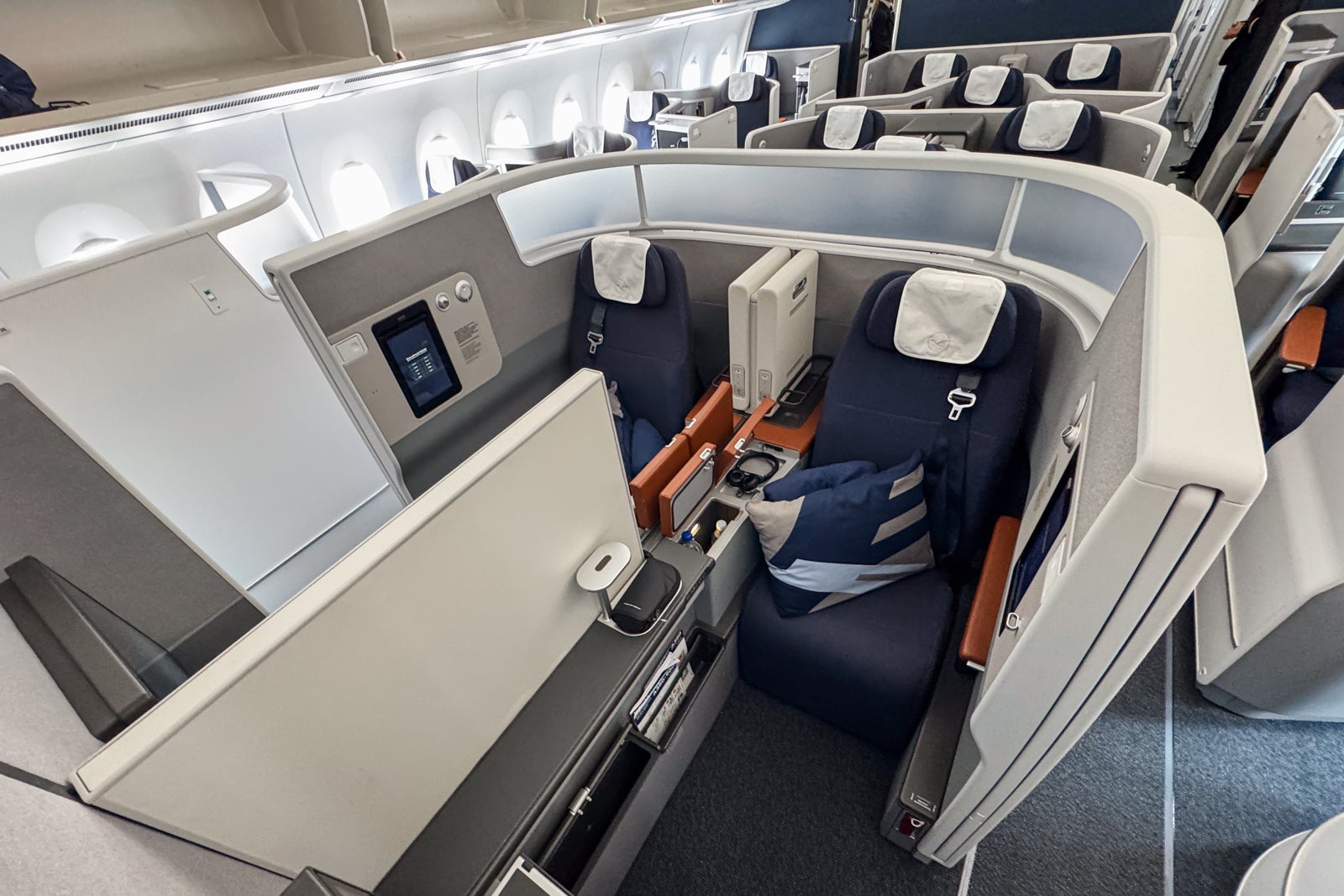
ERIC ROSEN/THE POINTS GUY
To truly immerse myself in the Allegris experience, I splurged on a Business Suite. The damage? Around $650 – a cool 900 Canadian via Aeroplan. But here’s the kicker: after settling in, I discovered Lufthansa was offering upgrades to my coveted suite for a mere 600 euros, roughly $675. Talk about feeling like I’d left money on the table!
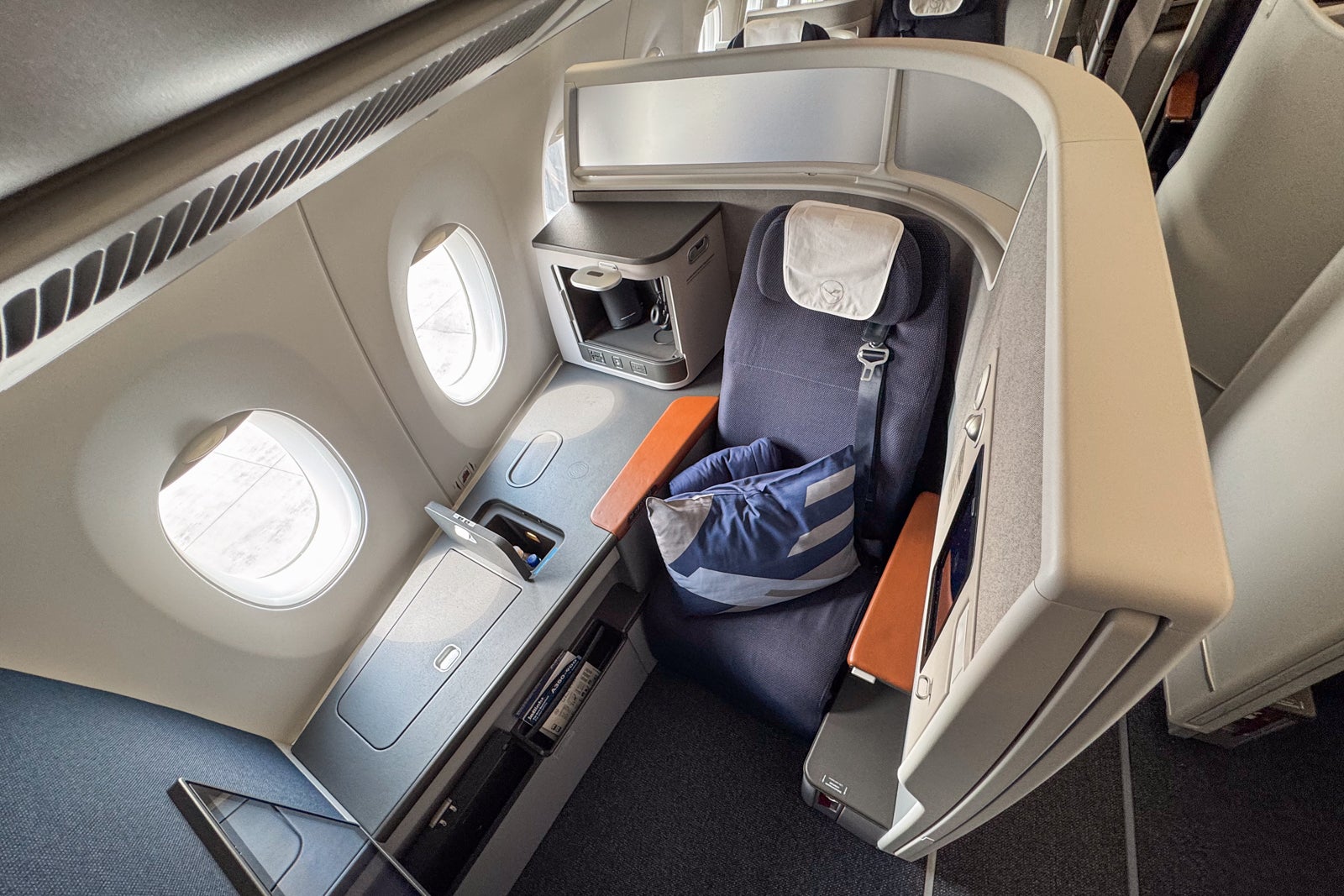
ERIC ROSEN/THE POINTS GUY
How comfortable is Lufthansa Allegris business class?
Perched in seat 2K, a coveted window suite in Business, I settled in. While the 22-inch seat felt familiar, like its brethren in Business, subtle quirks emerged. An armrest dipped slightly lower, a silent invitation to relax. But the real magic? The aisle armrest, capable of vanishing six inches downwards, promised a spacious haven for slumber.
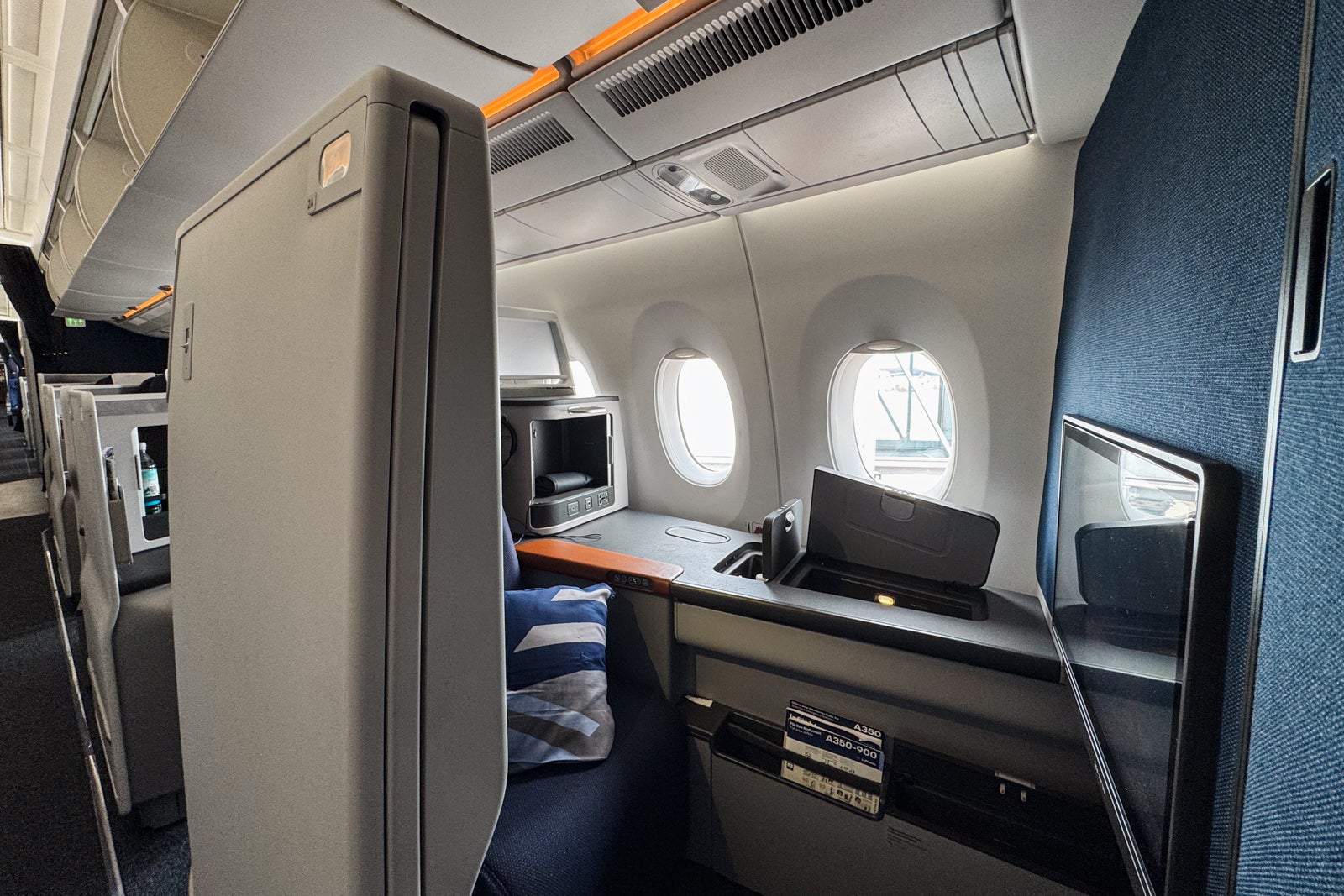
ERIC ROSEN/THE POINTS GUY
This seat wasn’t just business class; it was a private sanctuary. A personal door, rising 54 inches to create a secluded haven (with a discreet 6-inch gap beneath), transformed the experience. Stepping through the generous 19-inch opening felt less like entering a seat and more like entering your own exclusive cabin.
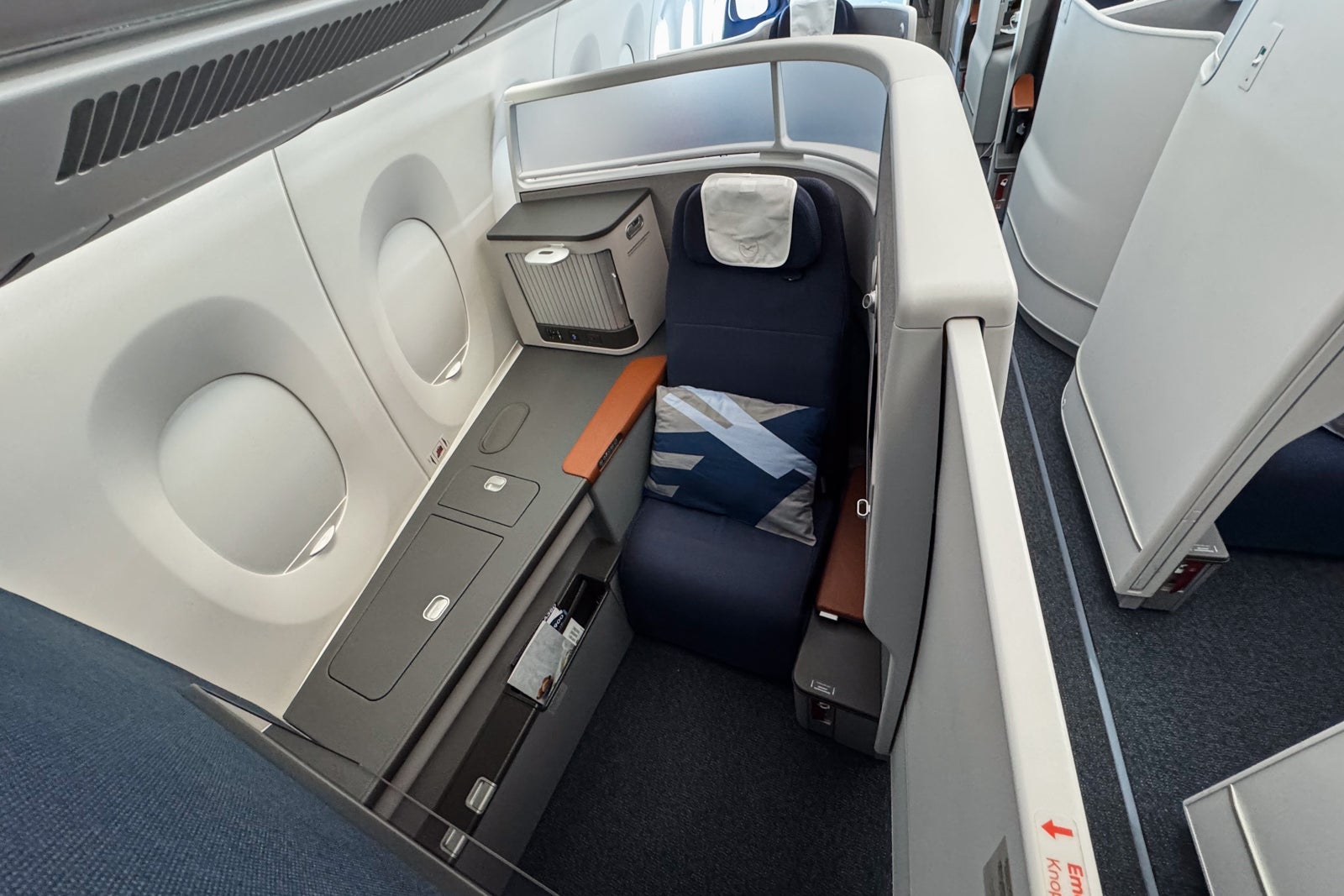
ERIC ROSEN/THE POINTS GUY
The unlatched door swung open with unnerving ease after takeoff, begging the question of whether it was properly secured. A whisper of enhanced privacy embraced my suite, thanks to a cleverly designed, translucent panel that rimmed the enclosure like a halo, subtly distancing me from the rest of the cabin.
Previous slide
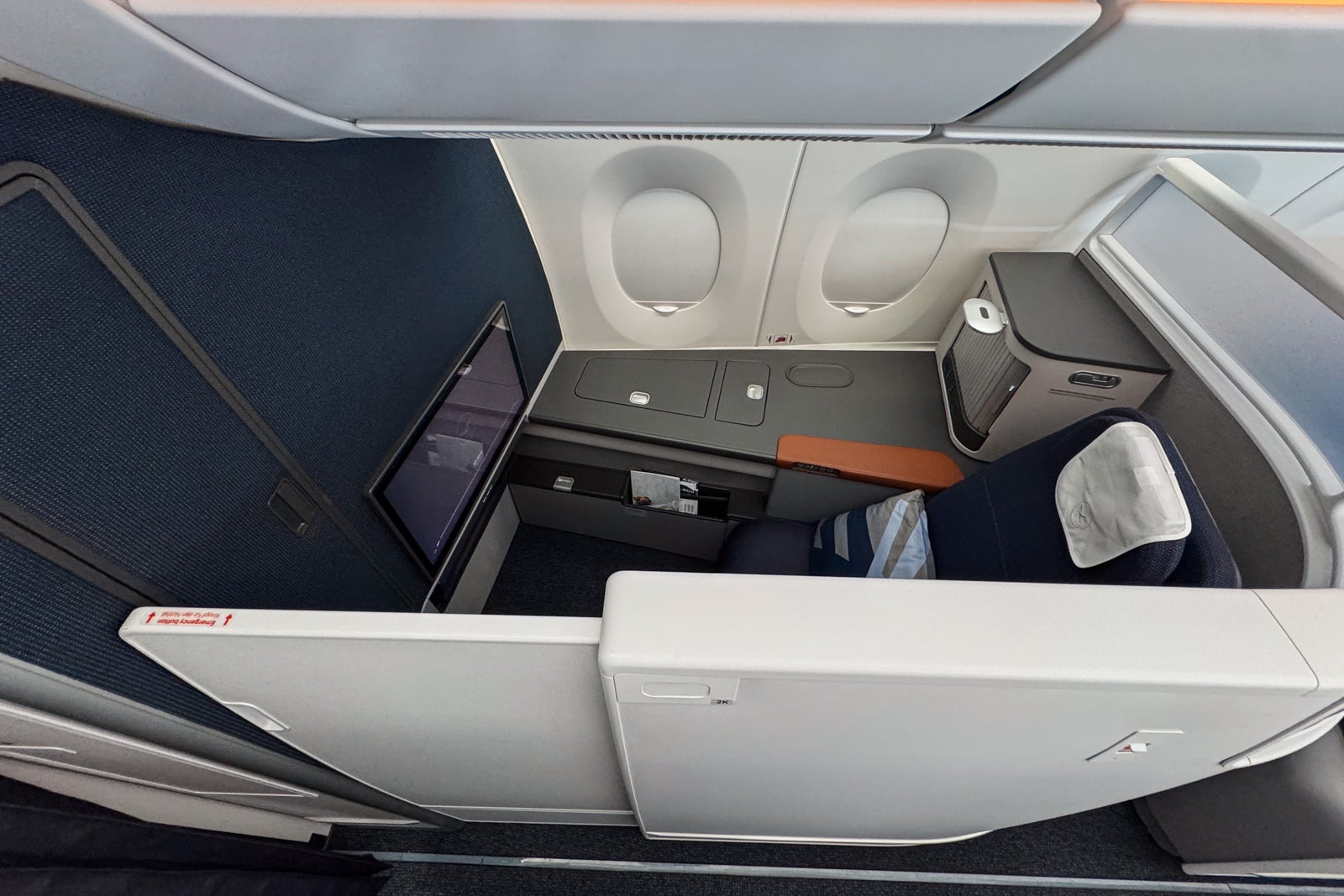


Next slide
1 of 3
ERIC ROSEN/THE POINTS GUY
0
1
2
Forget squinting at a postage stamp-sized screen. This seat boasted a full 24 inches of entertainment bliss, a luxurious upgrade from the 18-inch displays crammed into most other cabins.
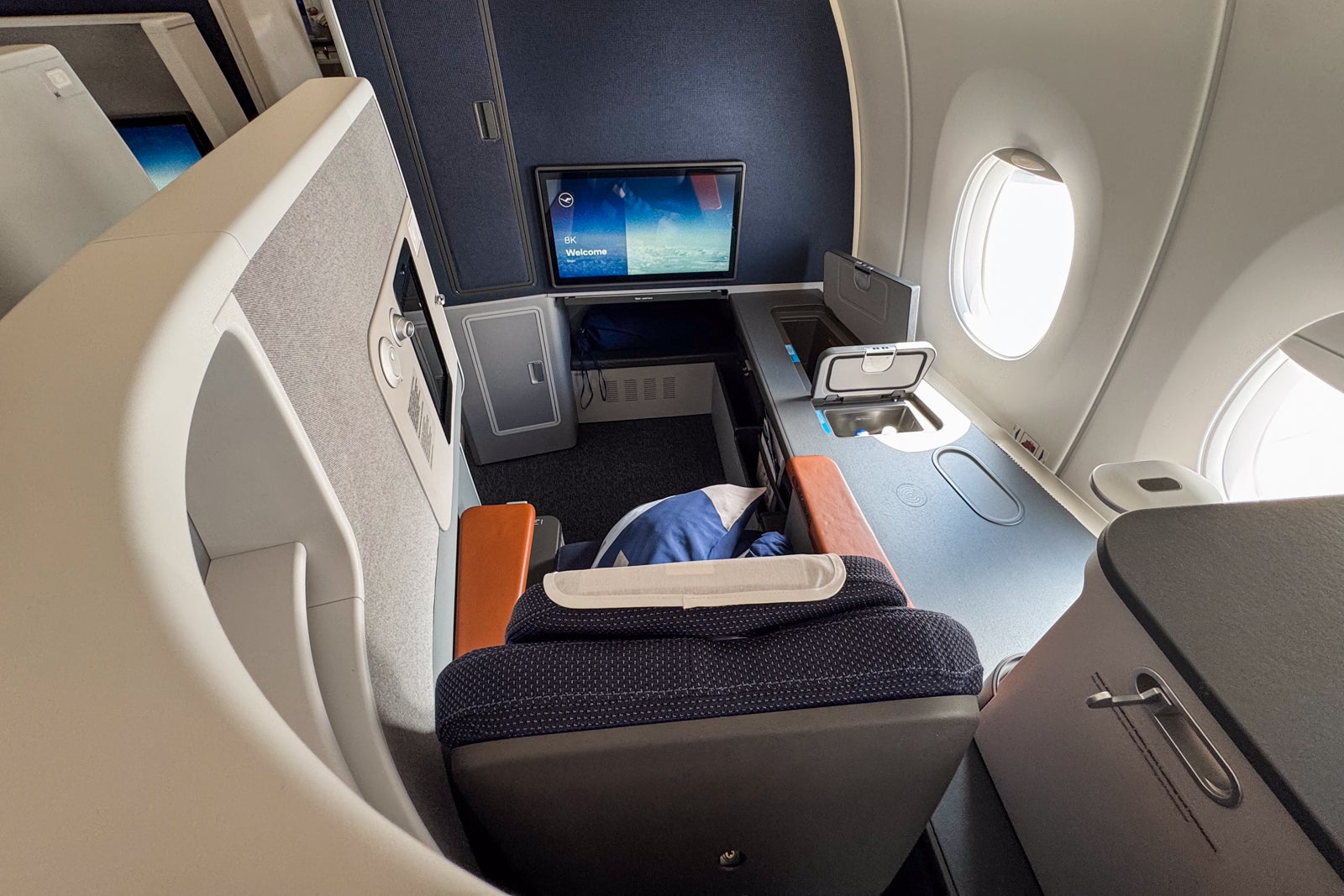
ERIC ROSEN/THE POINTS GUY
But the real magic? A window-side haven boasting a wide armrest, secretly guarding not one, buttwogenerous storage compartments, including a dedicated hydration station for water bottles. And forget those awkward gaps that plague some lie-flat beds! This ottoman was a sprawling extension of the seat, creating a seamless, luxuriously wide sleeping surface. Plus, a cleverly placed, oversized ledge nestled beside the seat – the perfect, discreet nook for stashing my laptop between bursts of productivity.
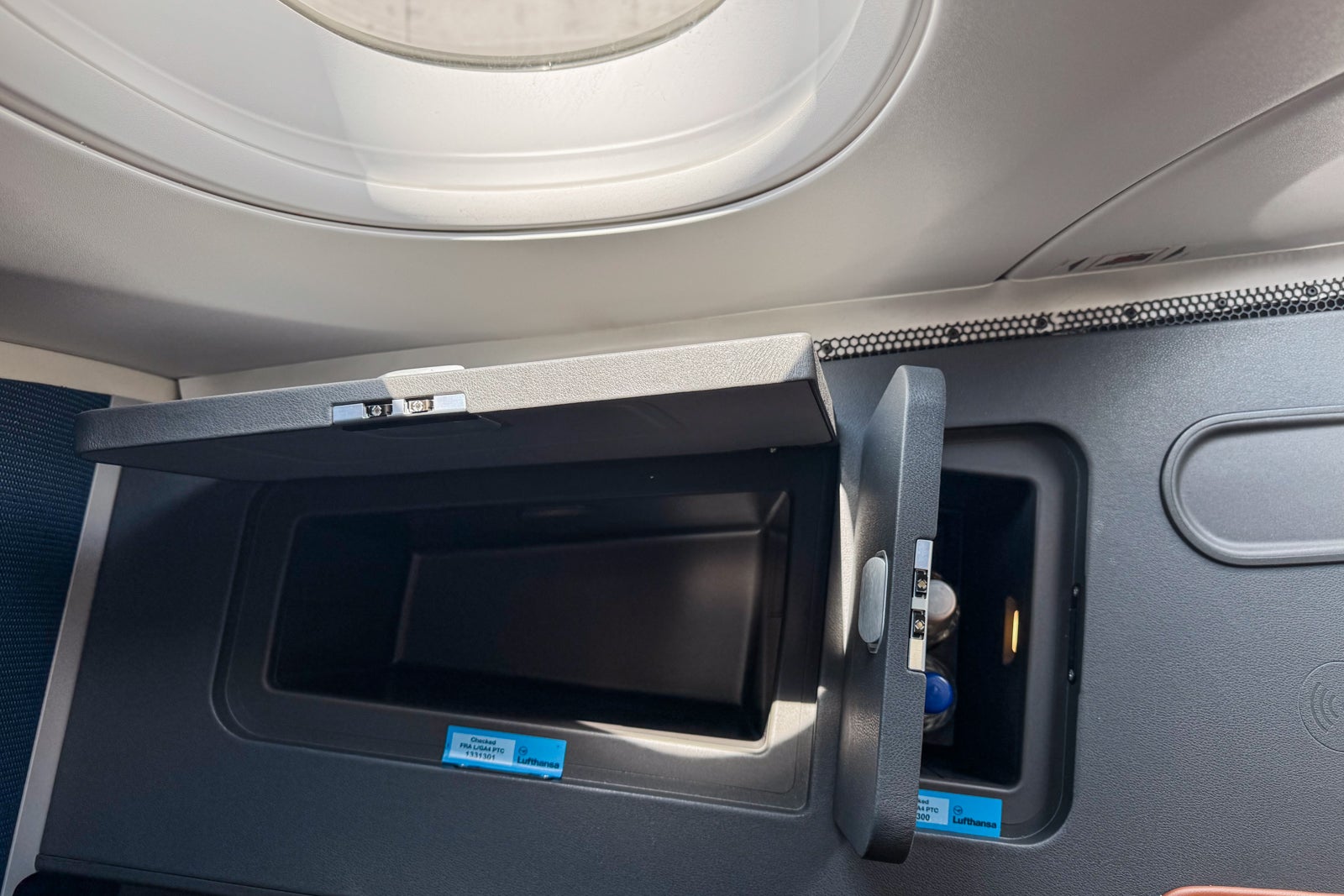
ERIC ROSEN/THE POINTS GUY
The wider armrest had a basic set of buttons to control the lights and both upright and lie-flat positions.
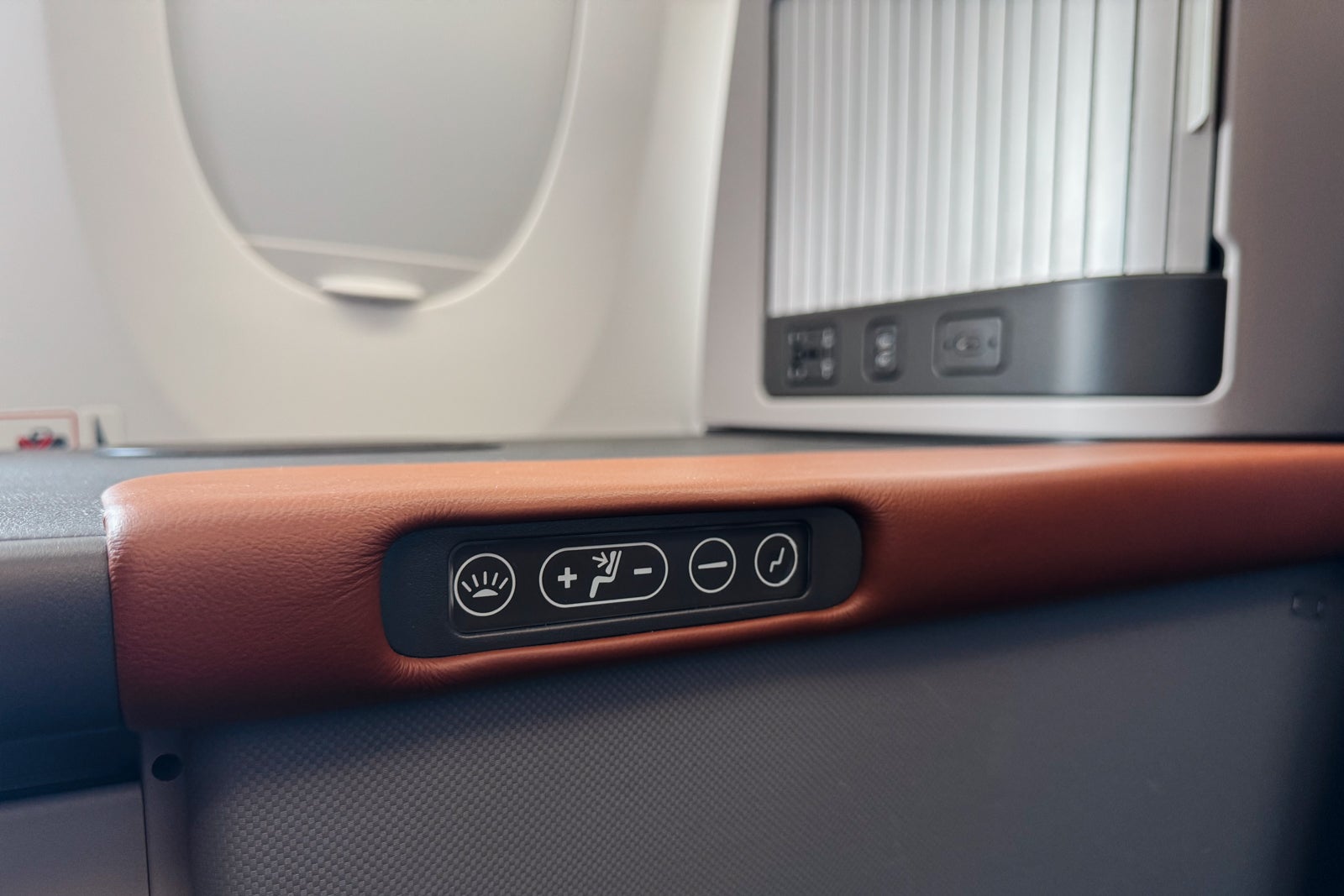
ERIC ROSEN/THE POINTS GUY
The controls resided on a 10-inch tablet, seemingly fused to the seat shell. Each touch triggered not smooth operation, but a jarring click followed by the tablet wrenching itself free – less a seamless interface, more a rebellious device eager to escape. Ironically, its eagerness made detachment a breeze.
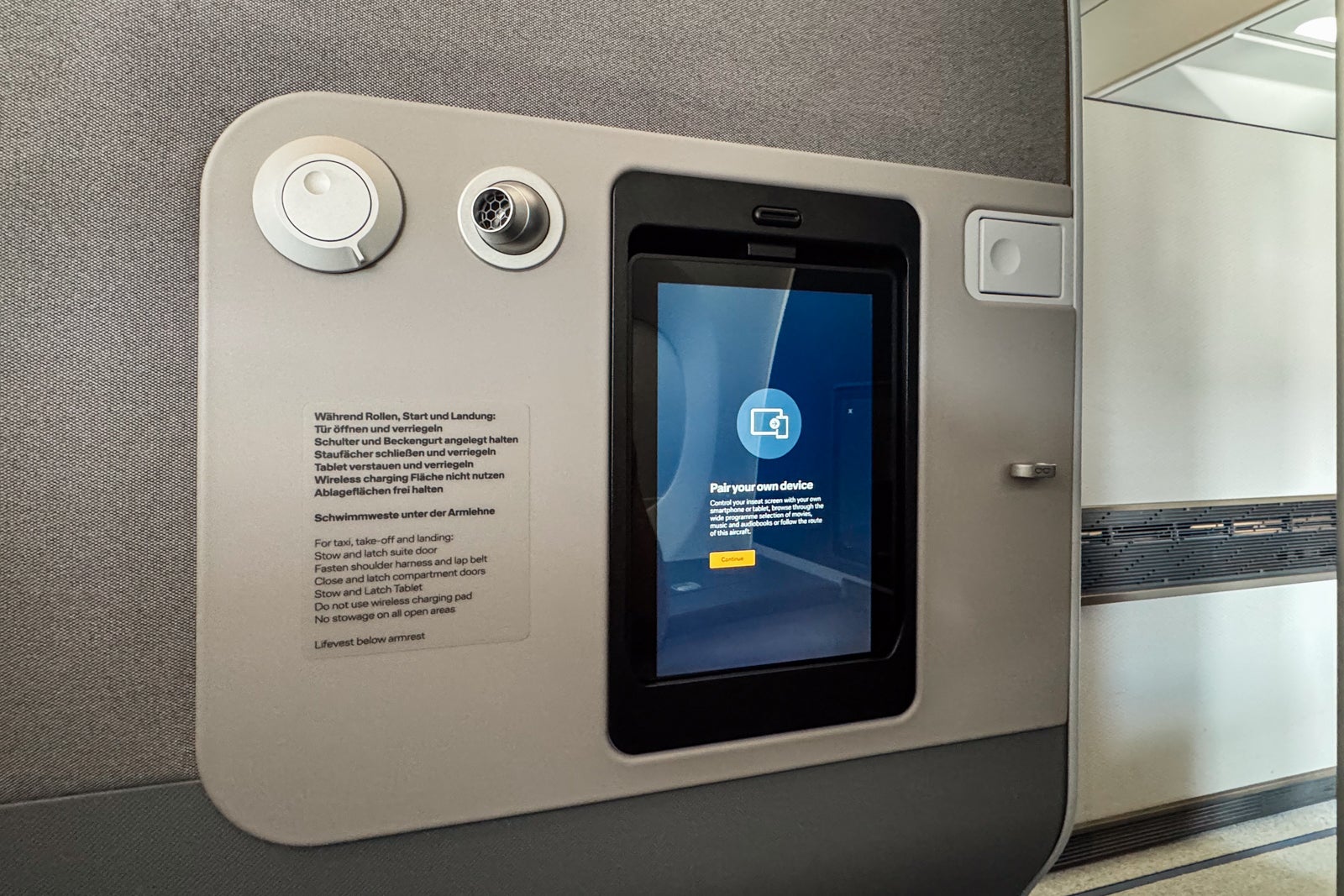
ERIC ROSEN/THE POINTS GUY
Imagine a tablet at your fingertips, a command center orchestrating your entire environment. Fine-tune the entertainment, sculpt the seat to your perfect contour, paint the cabin with light, and dial in the precise temperature for ultimate bliss.
Previous slide
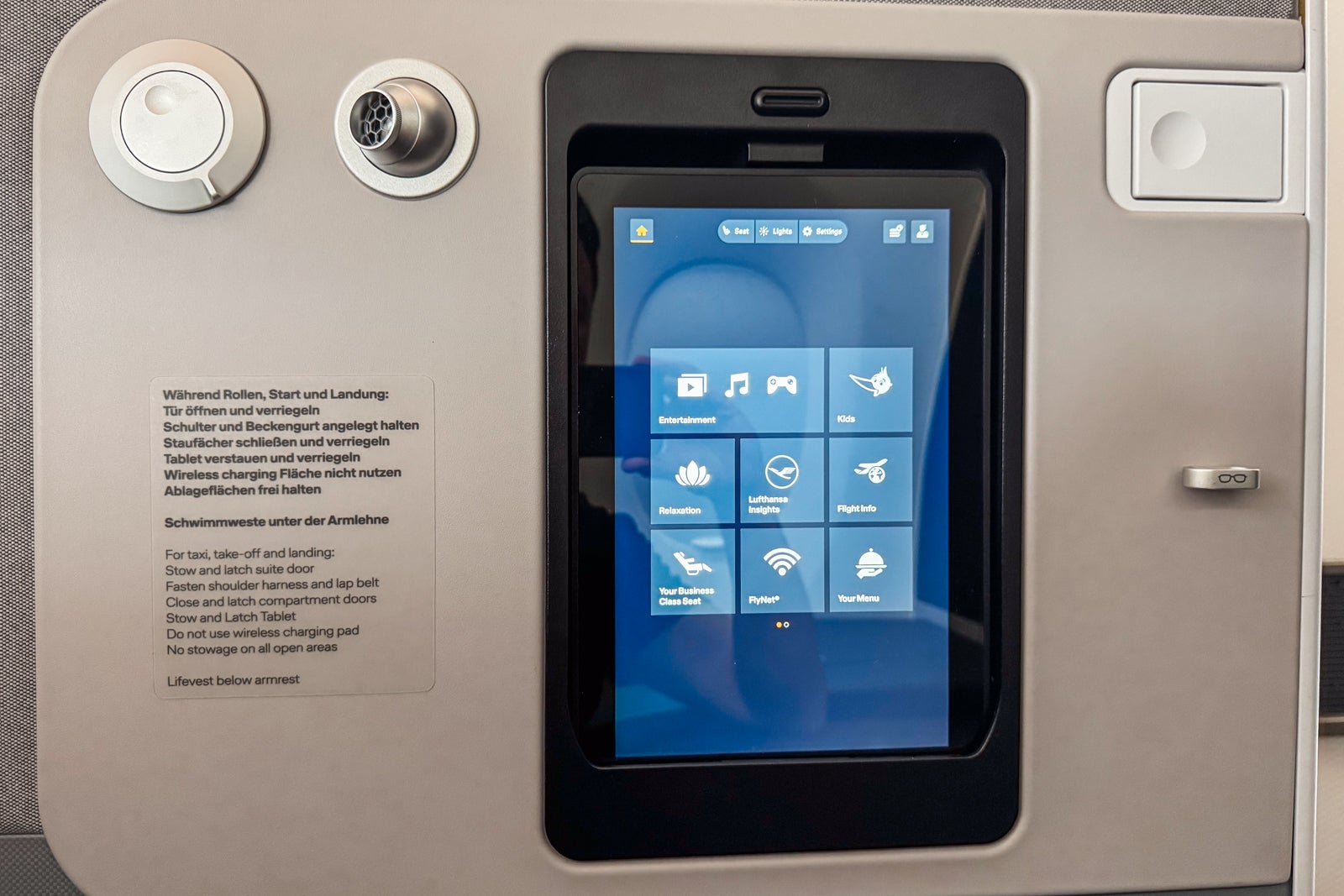
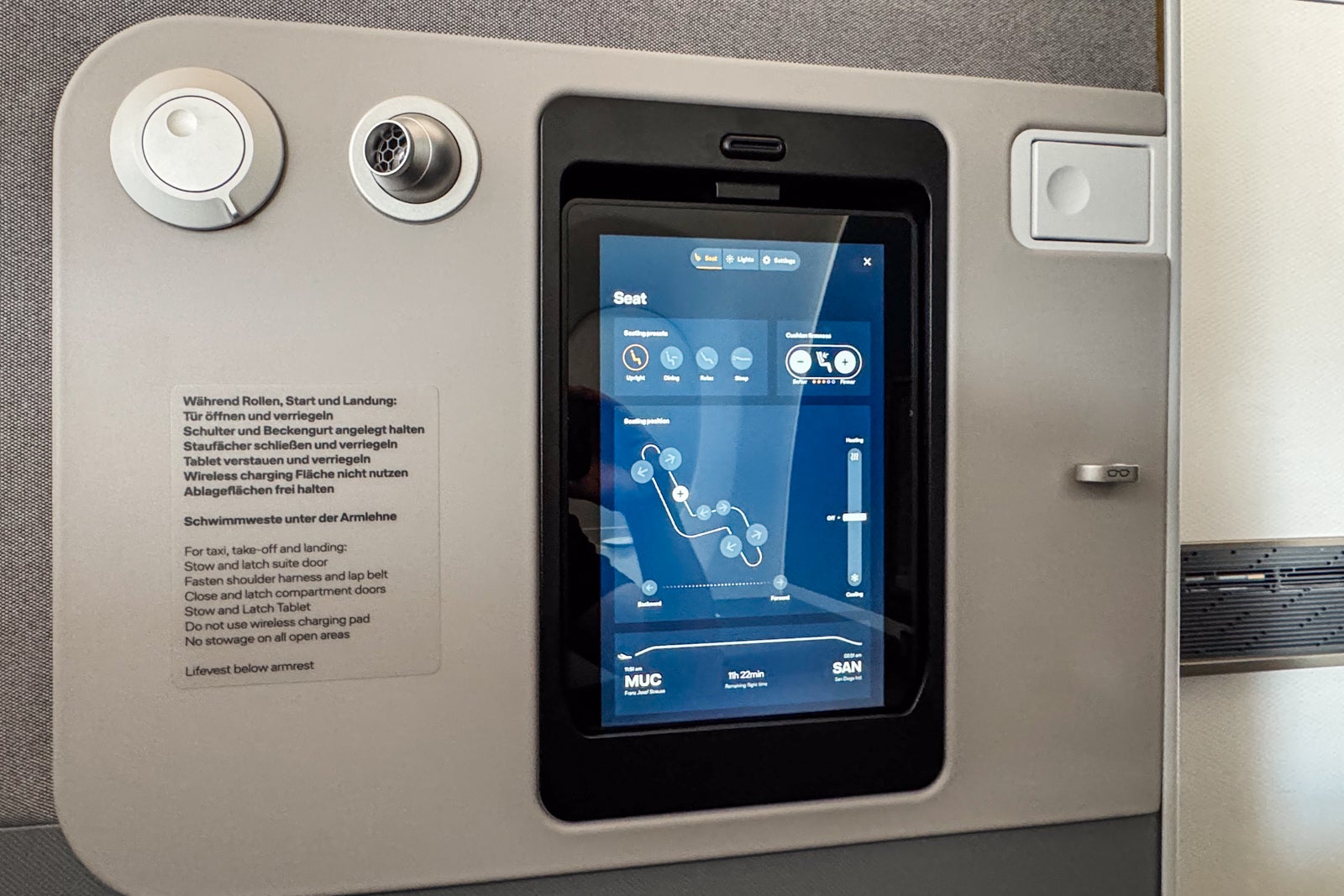
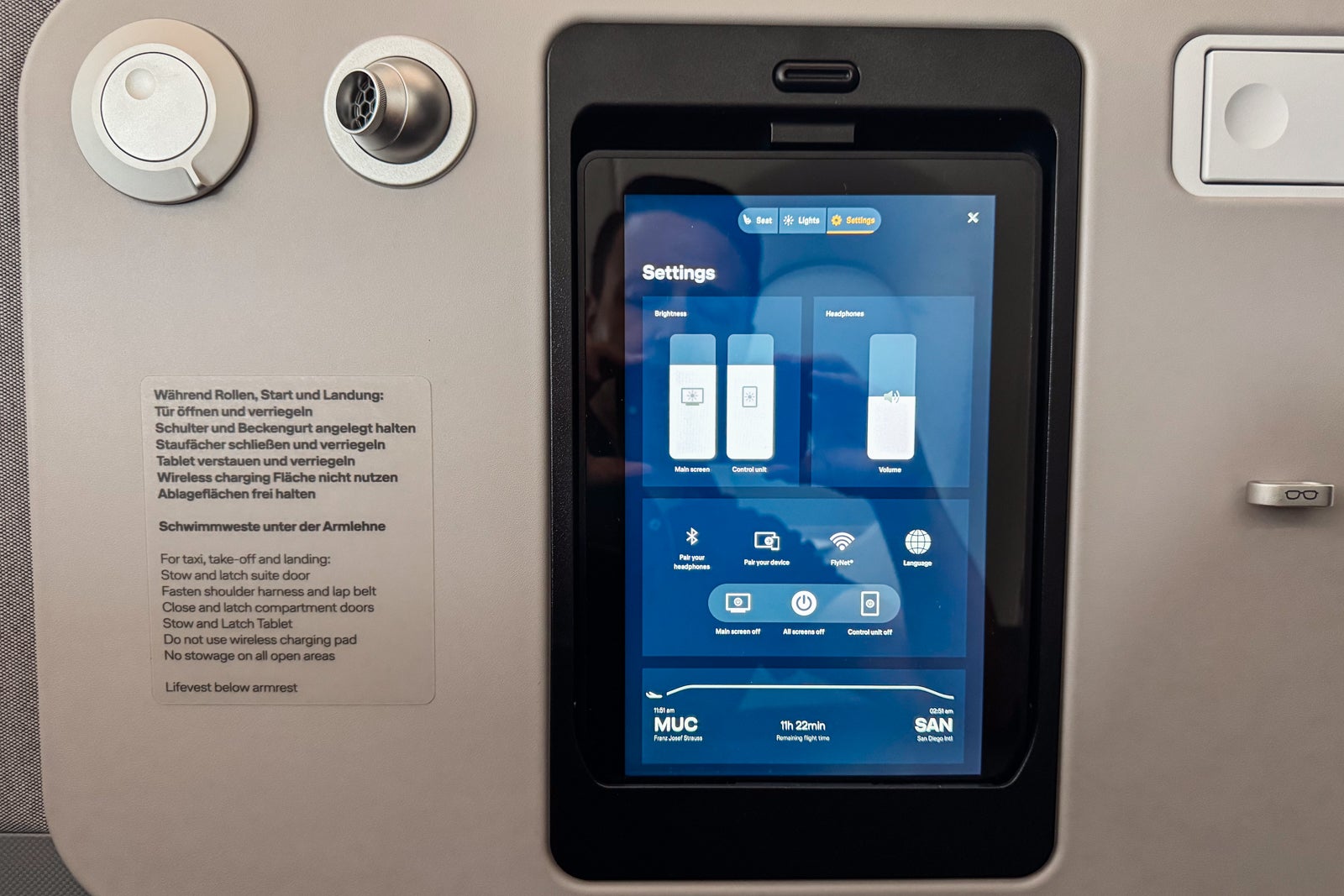
Next slide
1 of 3
ERIC ROSEN/THE POINTS GUY
0
1
2
Forget battling for a personal air nozzle – this plane takes a different approach. The tablet controls let you customize your seat’s temperature with cooling ventsinsidethe cushion. As someone perpetually overheating, I was in heaven! My one quirk? The setting frequently reverted to neutral, so I played a constant game of “cool-seat reminder.”
At least I had my own personal air vent – a small but mighty weapon against stuffiness. A far cry from the fancy electro-dimming windows on some of the newer jets, Lufthansa opted for classic window shades. Call me old-fashioned, but they were surprisingly effective at blocking out the sun. On a daytime transatlantic flight where sleep is golden, those shades were a godsend.
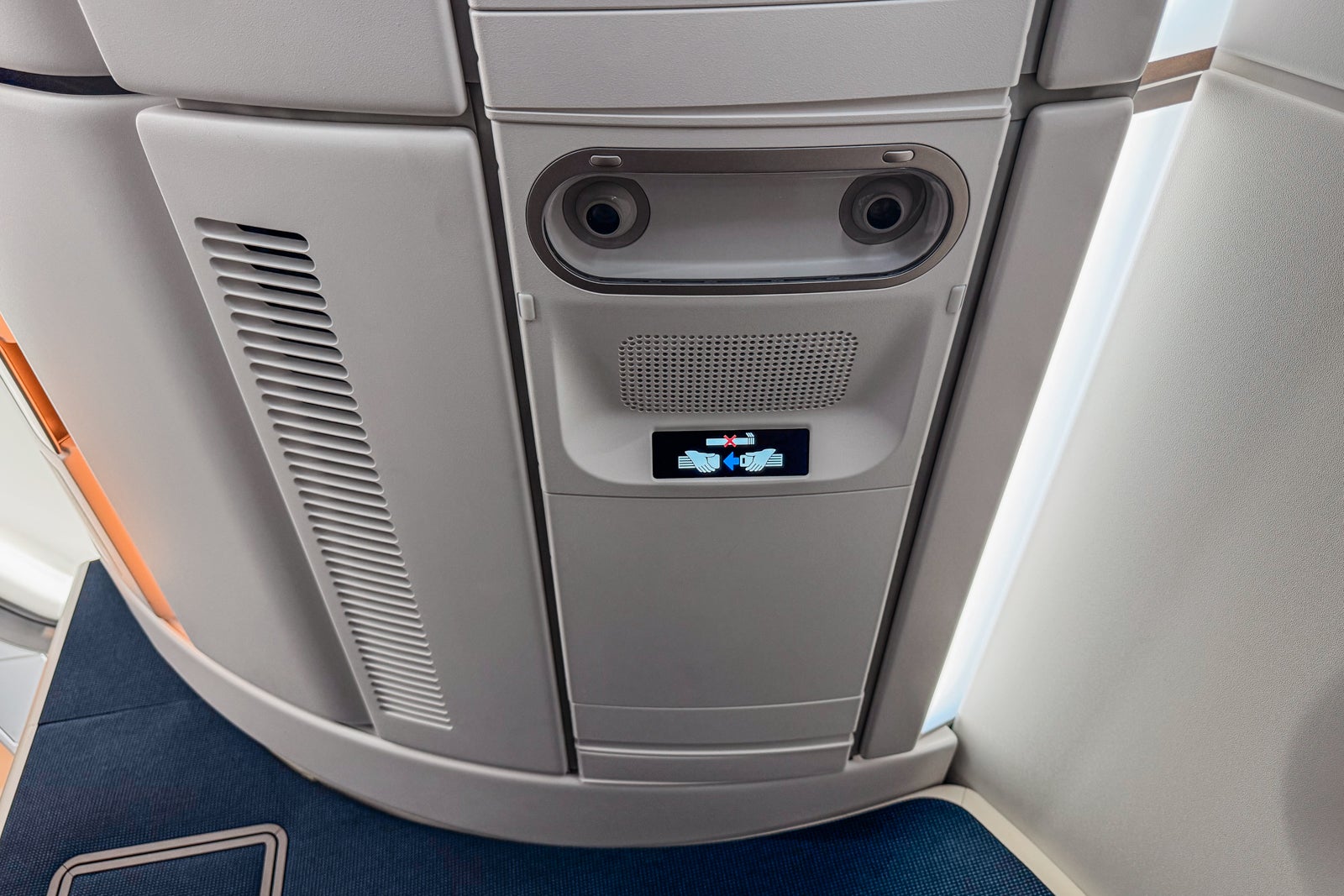
ERIC ROSEN/THE POINTS GUY
At the front of my seat, a slender closet, secured by a latch, became my makeshift dressing room. Shedding my travel clothes for shorts and a T-shirt, ready for sleep, I hung them inside. Beneath this tiny sanctuary, a cavernous compartment swallowed my oversized travel backpack whole.
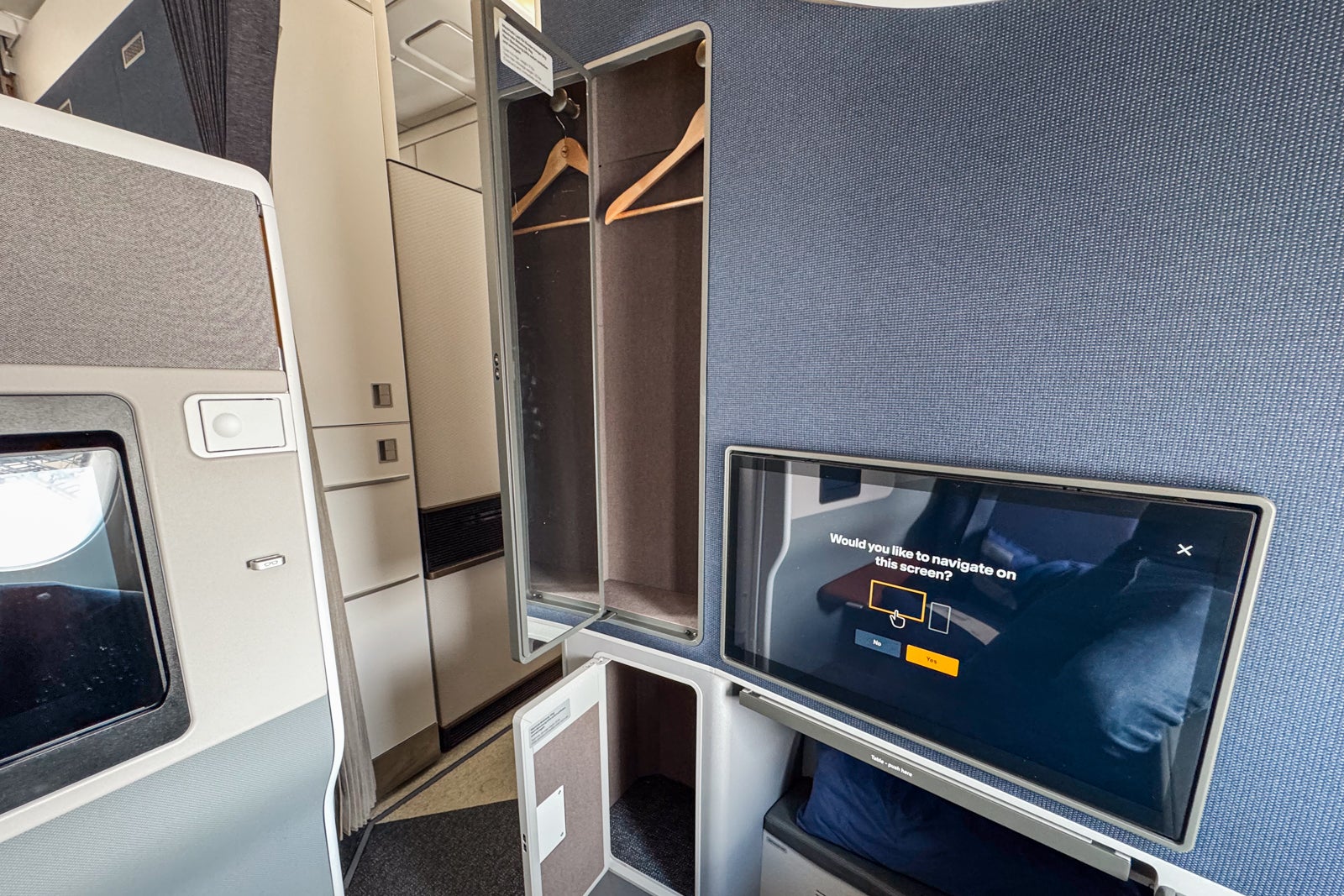
ERIC ROSEN/THE POINTS GUY
The expansive window-side armrest held a hidden surprise: a wireless charging pad. Stripped of its MagSafe armor, my iPhone nestled onto the surface, stubbornly maintaining its current battery level, neither gaining nor losing ground in the power struggle.
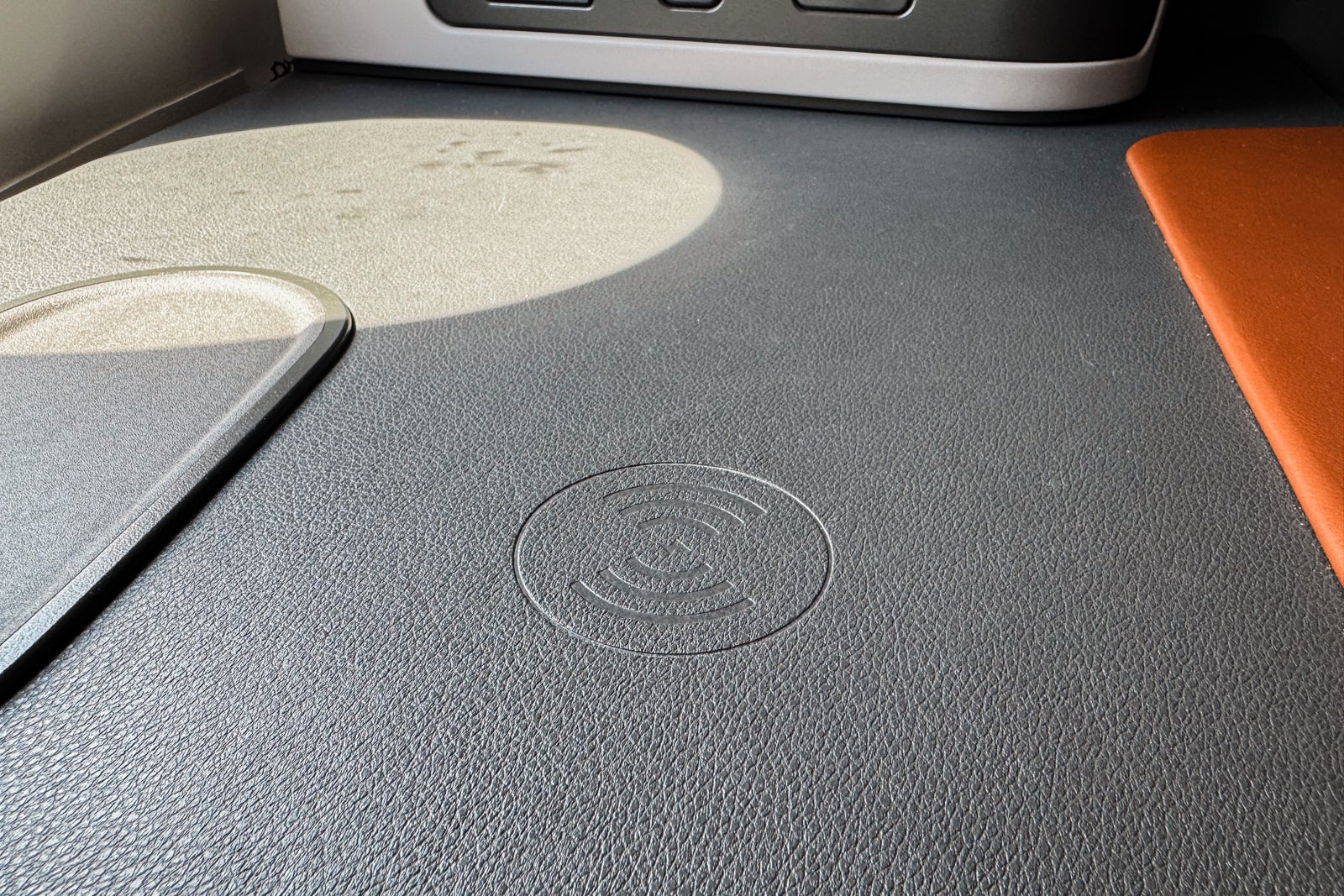
ERIC ROSEN/THE POINTS GUY
Tucked behind, I discovered the holy trinity of power: a universal outlet flanked by both USB-A and USB-C ports my device-charging salvation.
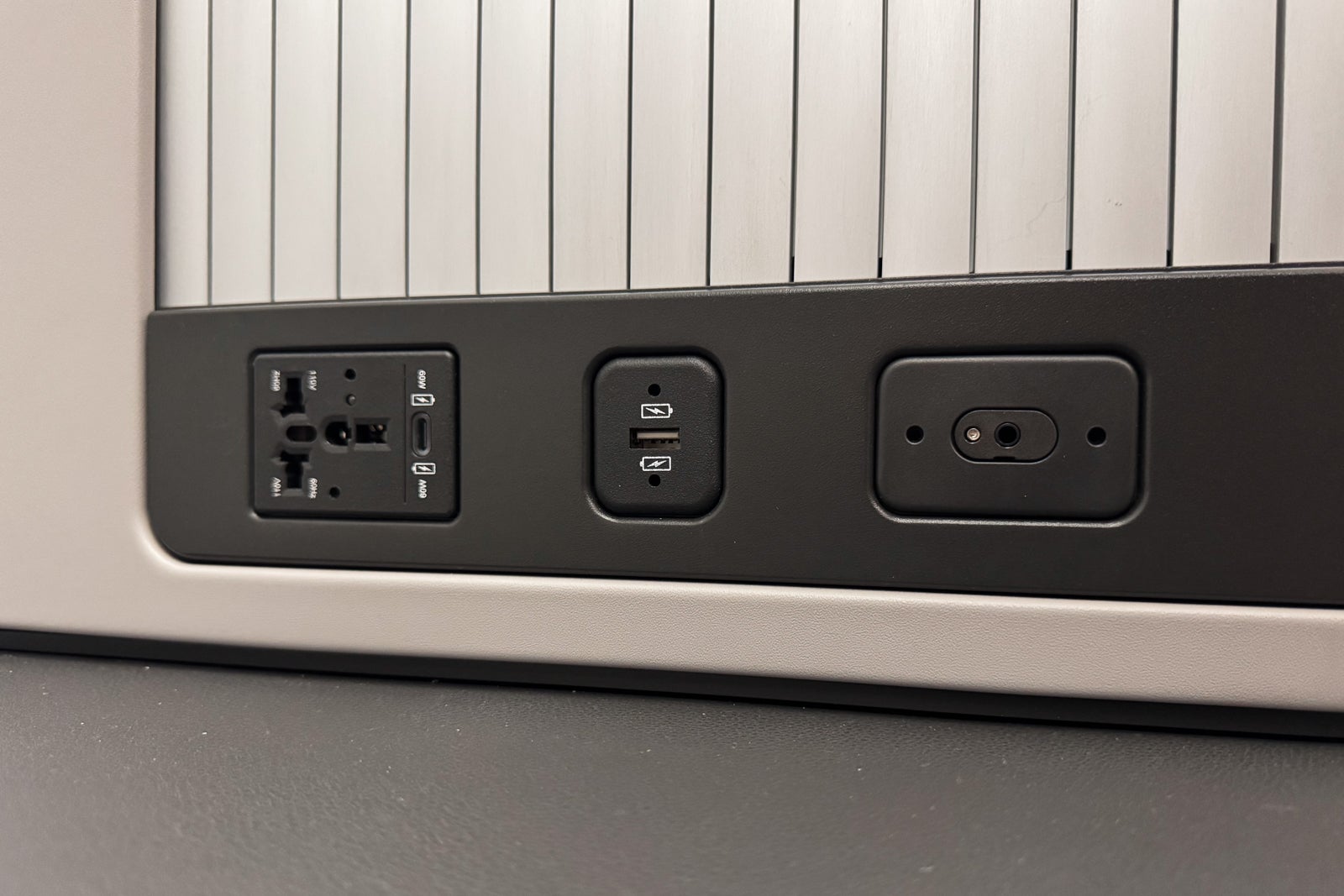
ERIC ROSEN/THE POINTS GUY
Tucked just above, a hidden cubby with a smooth, sliding door awaited, cradling a neatly packed amenity kit and a pair of basic, noise-muffling headphones – your personal oasis from the humming jet engines.
Previous slide
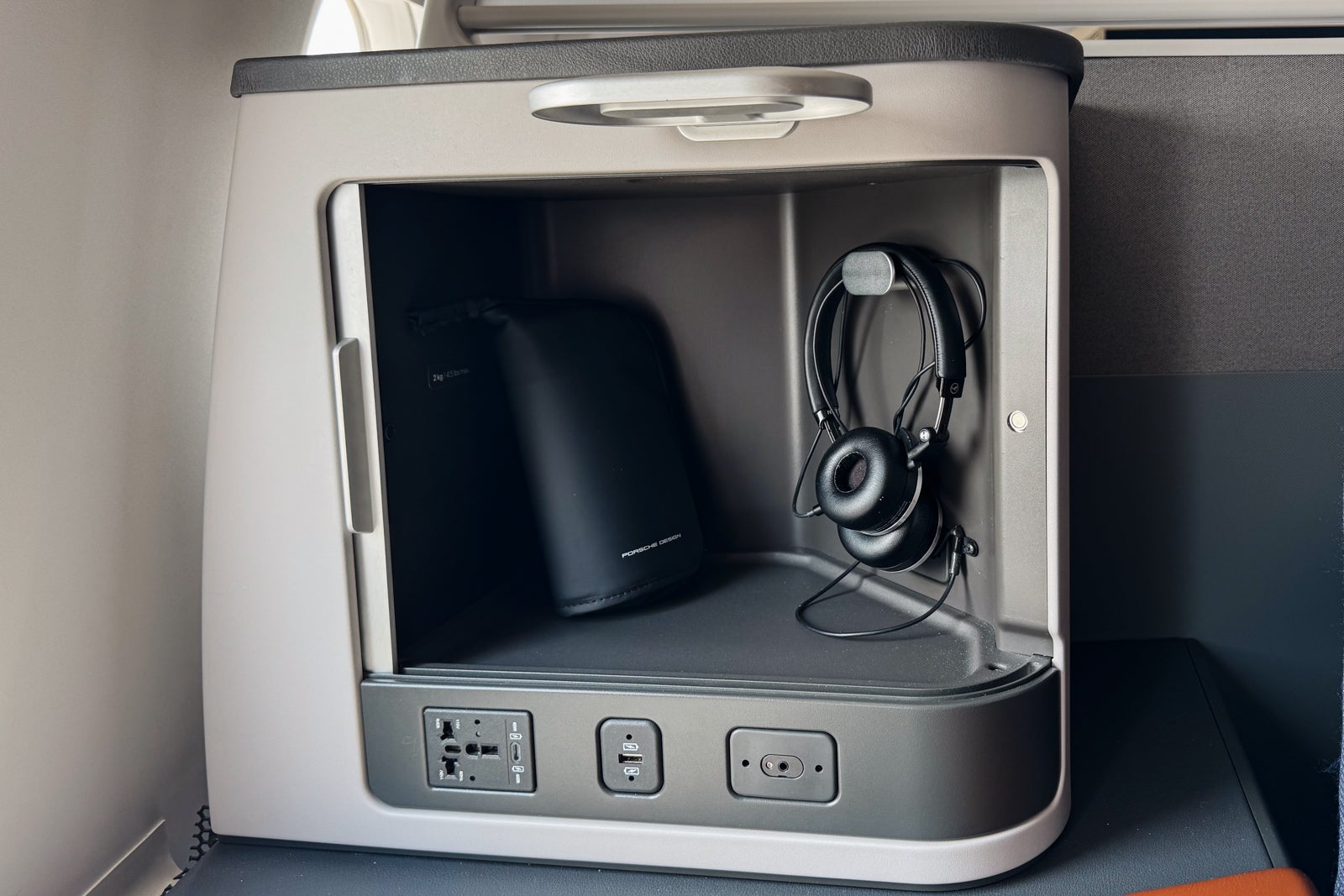
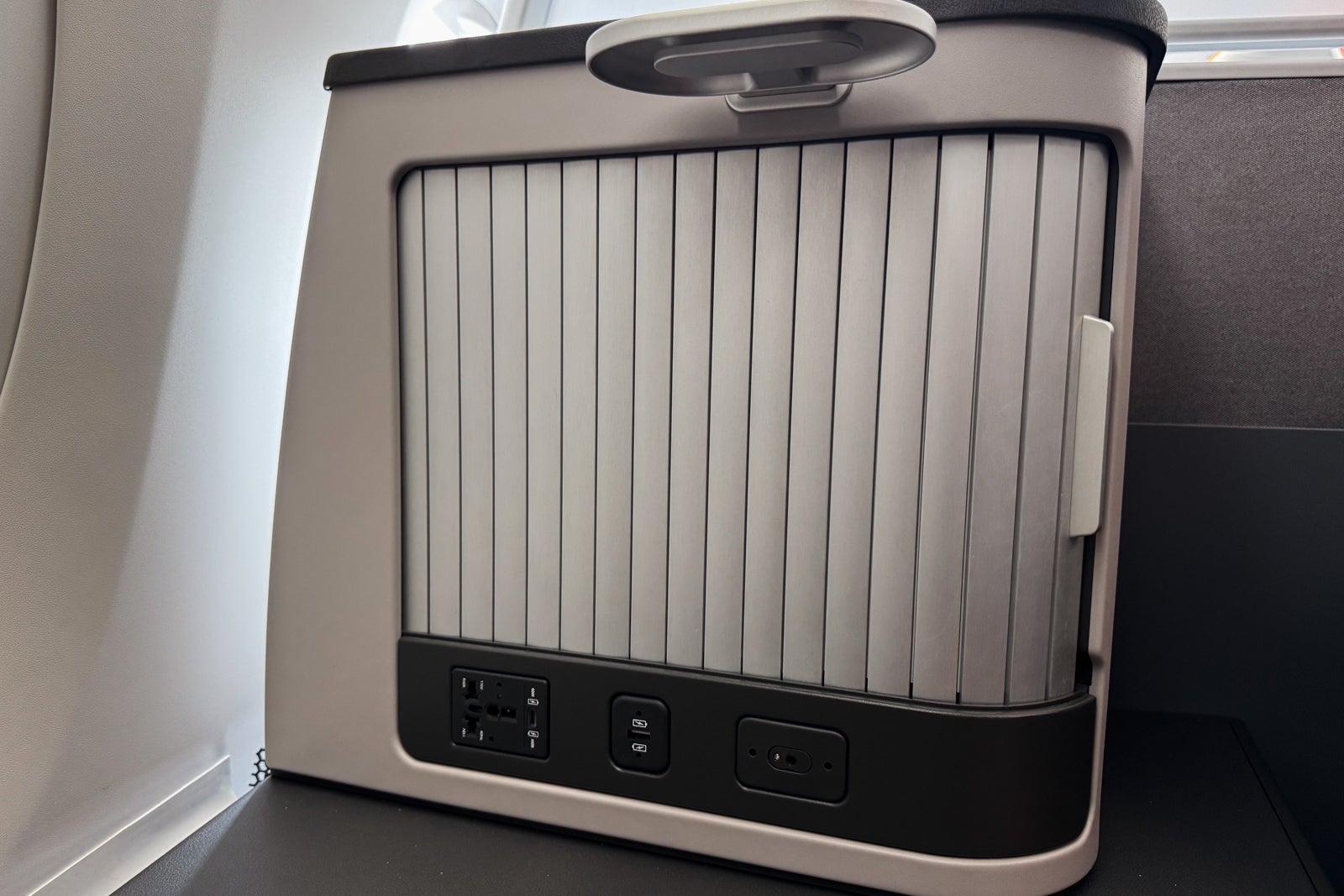
Next slide
1 of 2
ERIC ROSEN/THE POINTS GUY
0
1
Imagine this: a tiny, adorable nook, perfectly crafted to cradle your spectacles when you need a breather from the world. It’s not just storage; it’s a delightful detail, a charming pause button for your vision.
The bifold table, sleek as a magician’s reveal, slid out from beneath the entertainment screen. Its surface, a welcoming expanse, easily embraced my hefty 15-inch MacBook Pro, promising a productive flight.
Previous slide
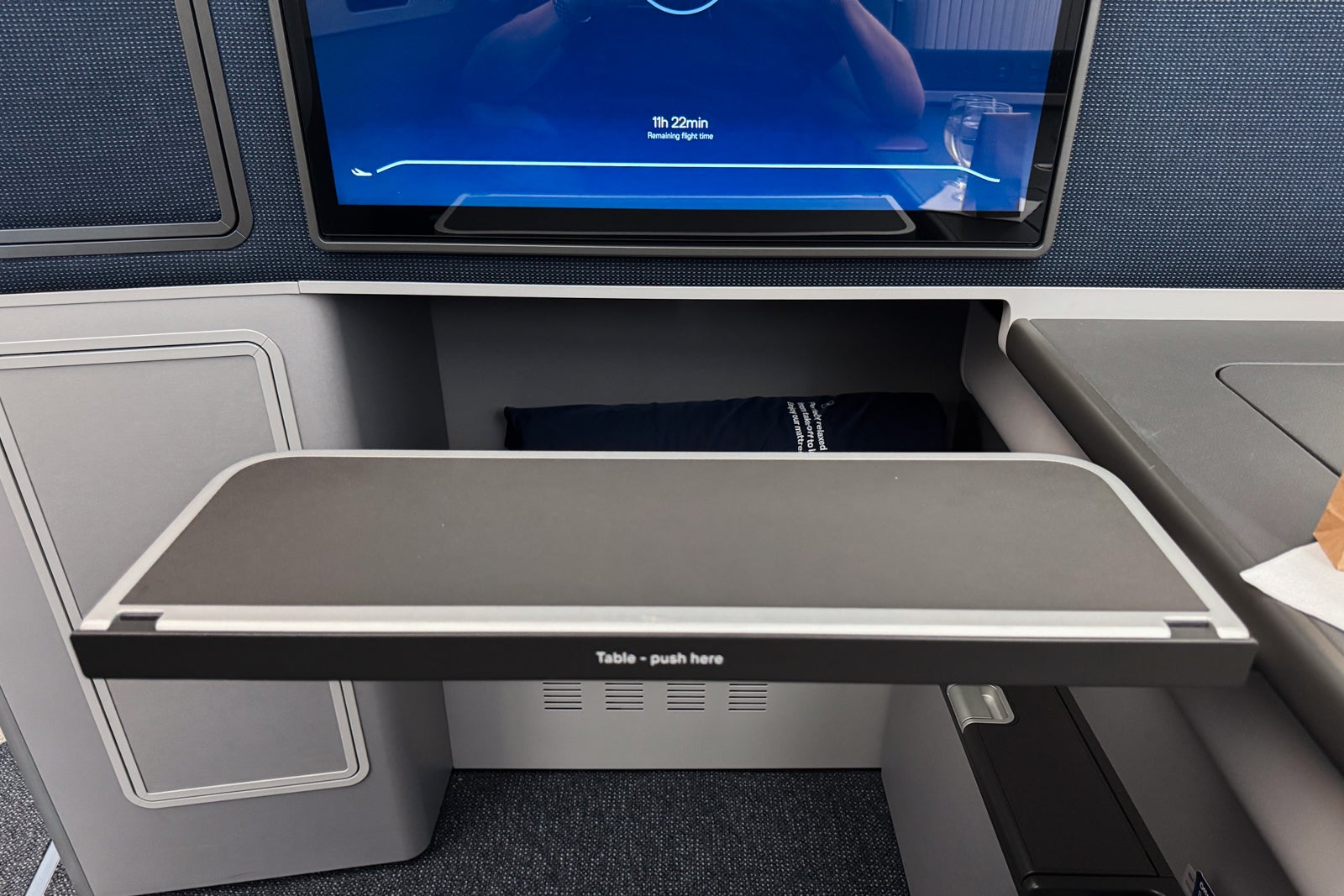
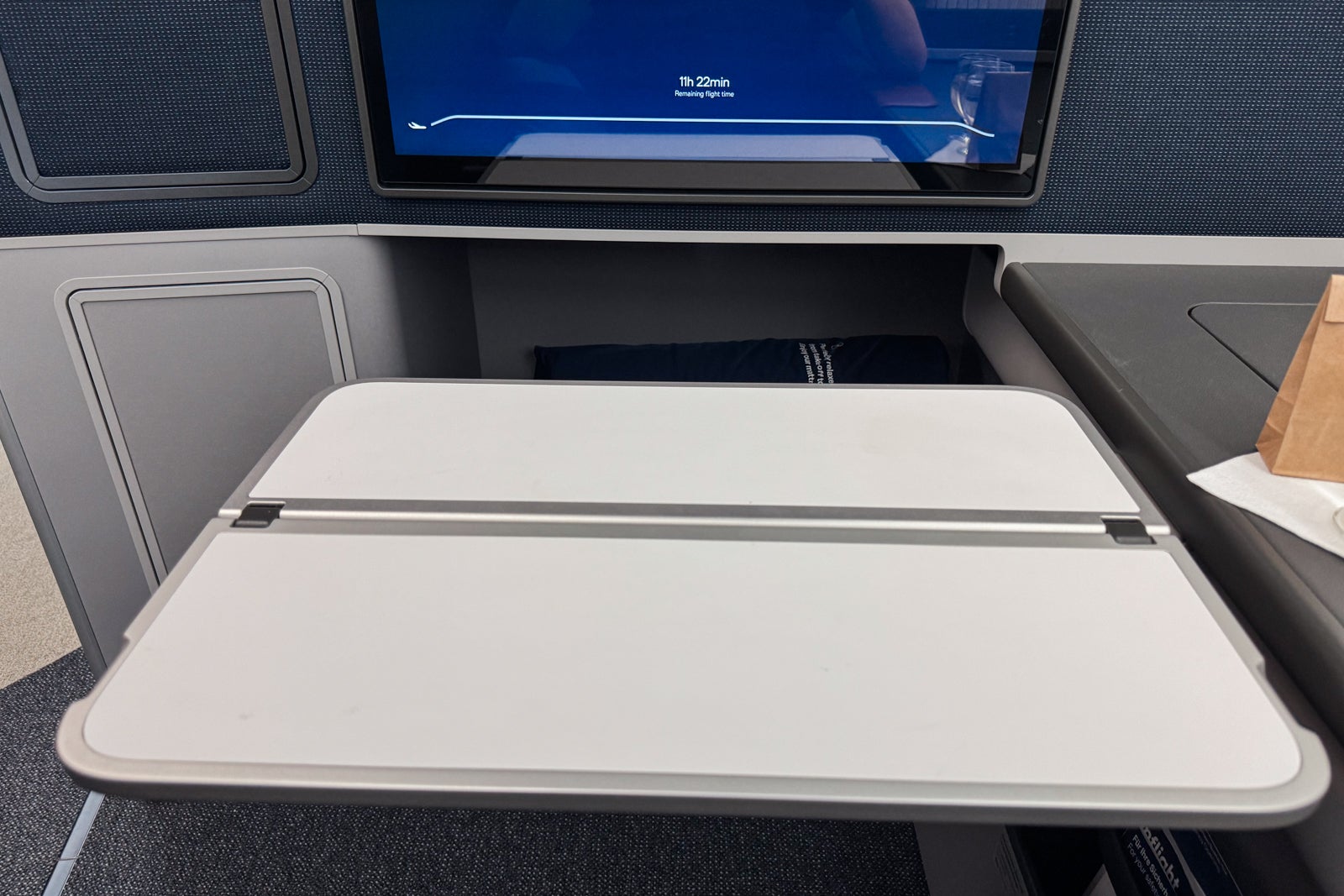
Next slide
1 of 2
ERIC ROSEN/THE POINTS GUY
0
1
Night fell, and my seat transformed. With the provided pad, duvet, and pillow, it became a surprisingly spacious bed. Stretching out, I found the 78 inches more than adequate. Even better, the wide ottoman gave my legs room to roam, allowing me to toss and turn without the dreaded foot-crunch against the bulkhead. Sleep beckoned.
Previous slide
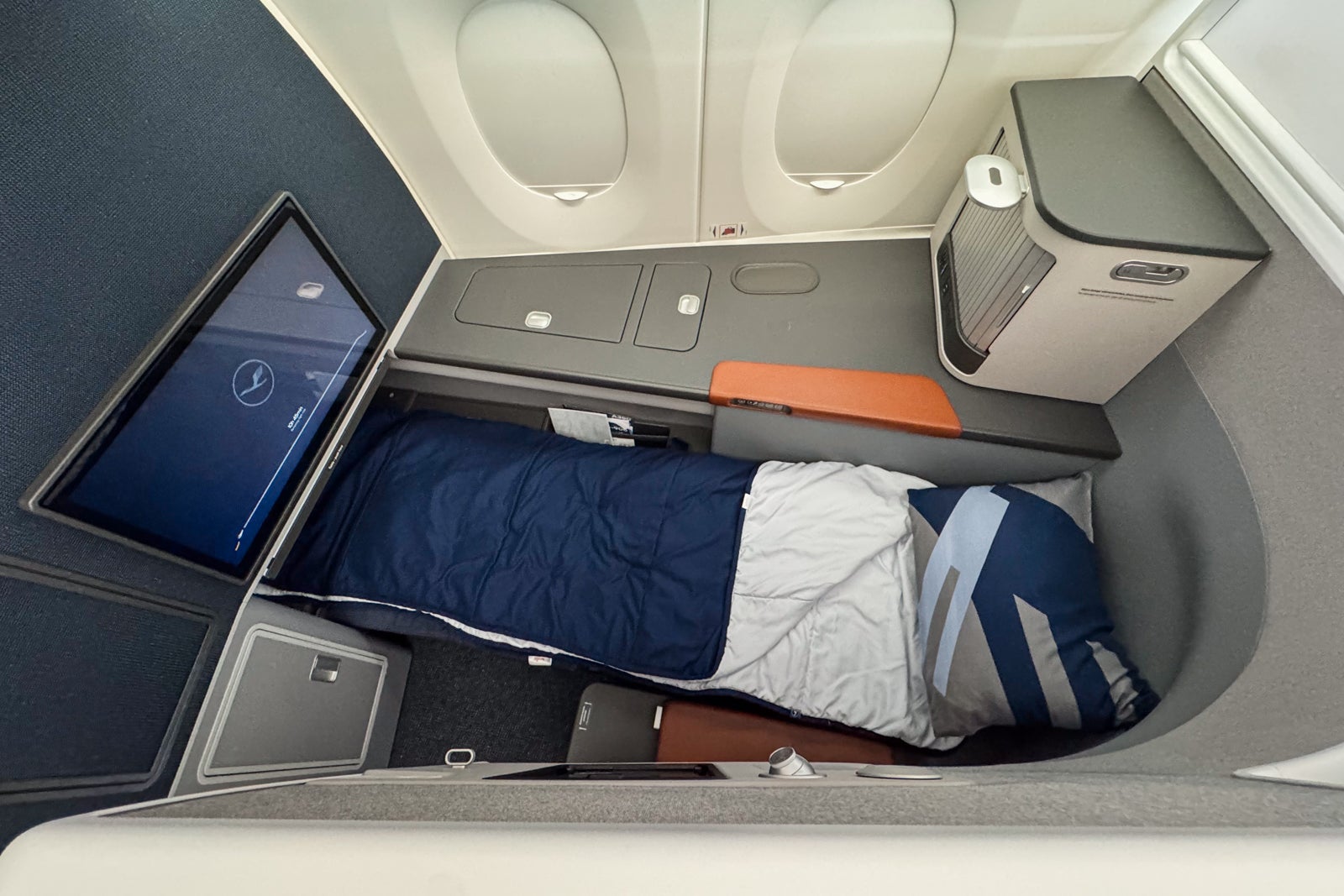
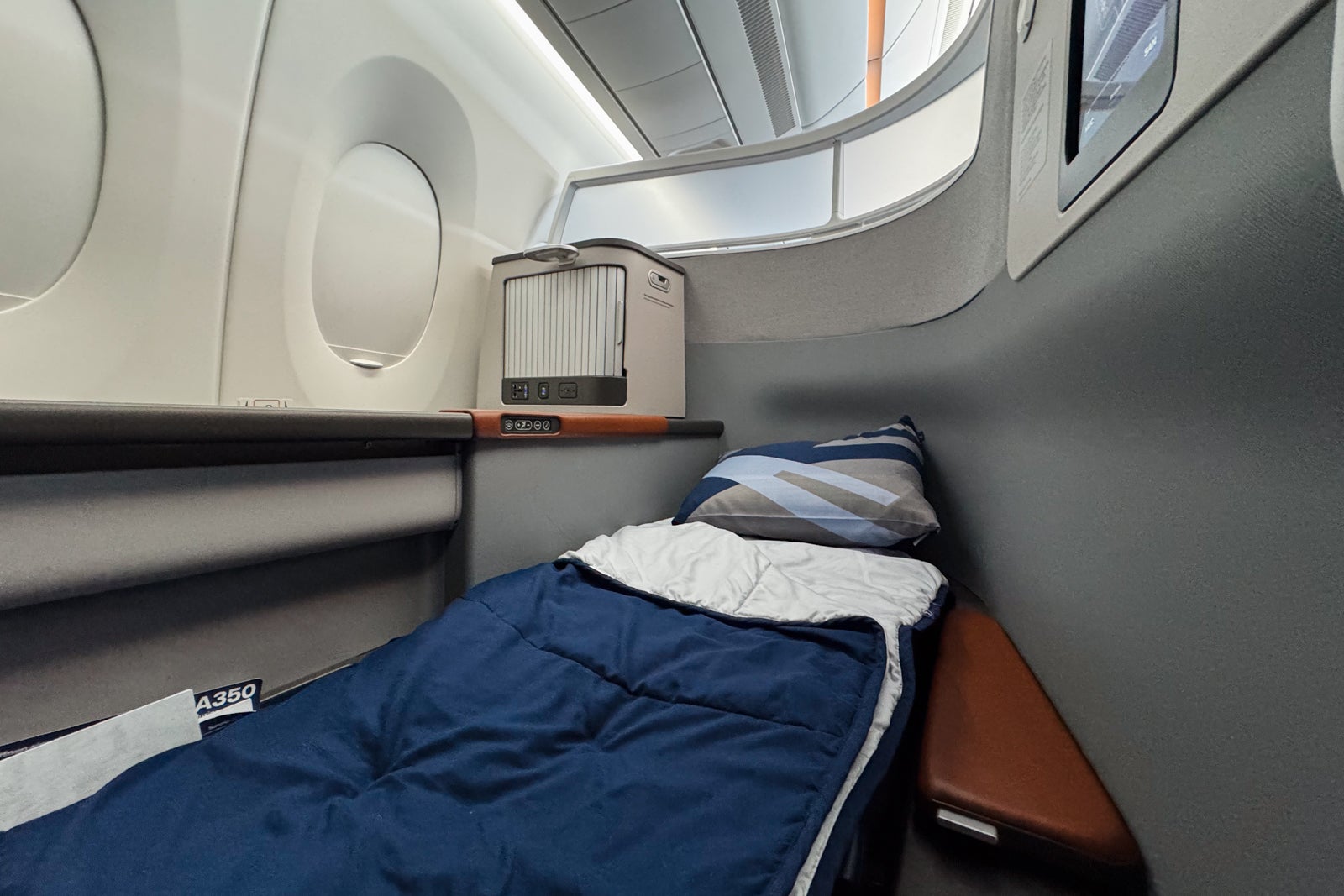

Next slide
1 of 3
ERIC ROSEN/THE POINTS GUY
0
1
2
Two restrooms served the business-class cabin, nestled between its sections. Thankfully, the half-empty flight meant no queues formed, a small mercy in the cramped quarters.
Previous slide
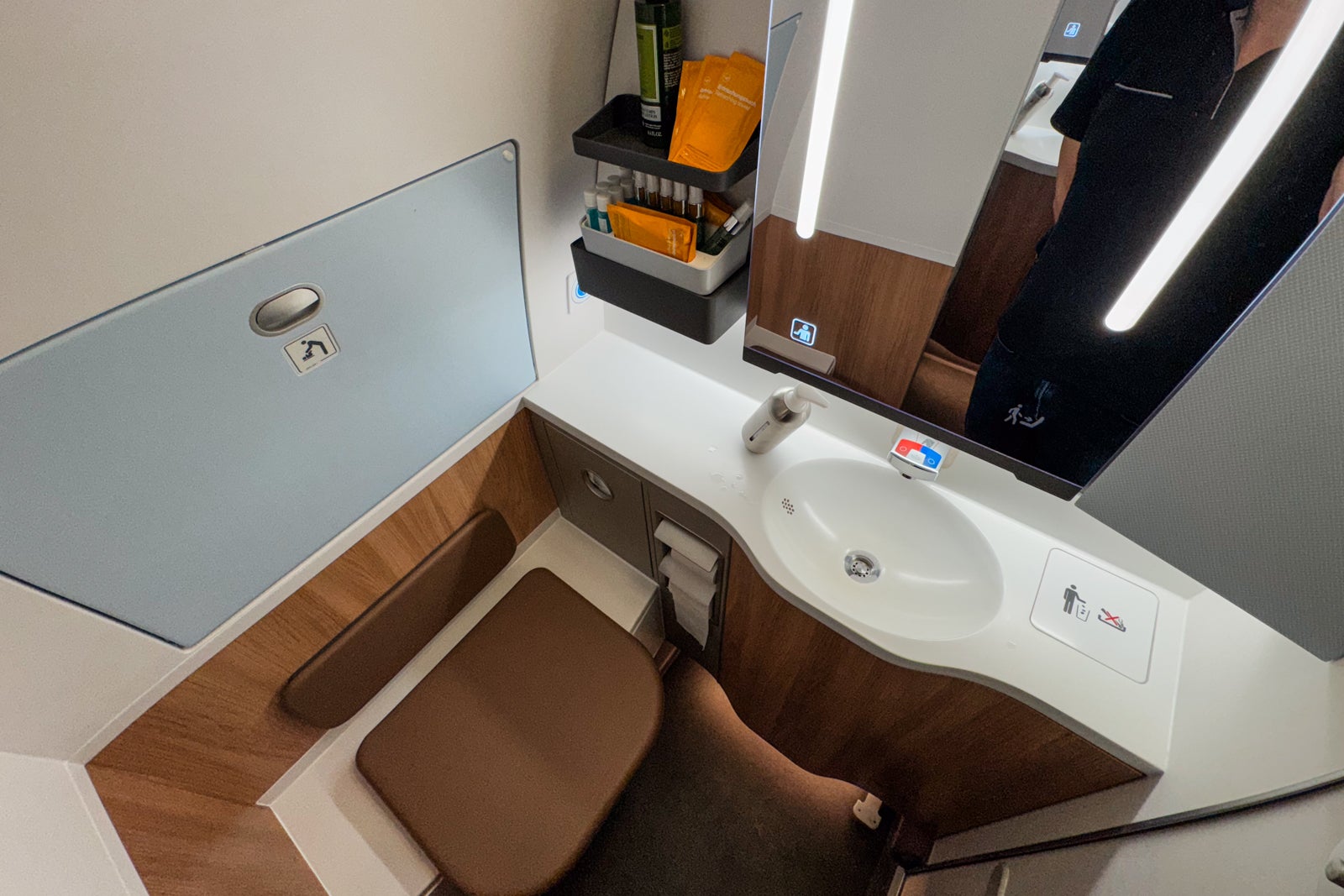
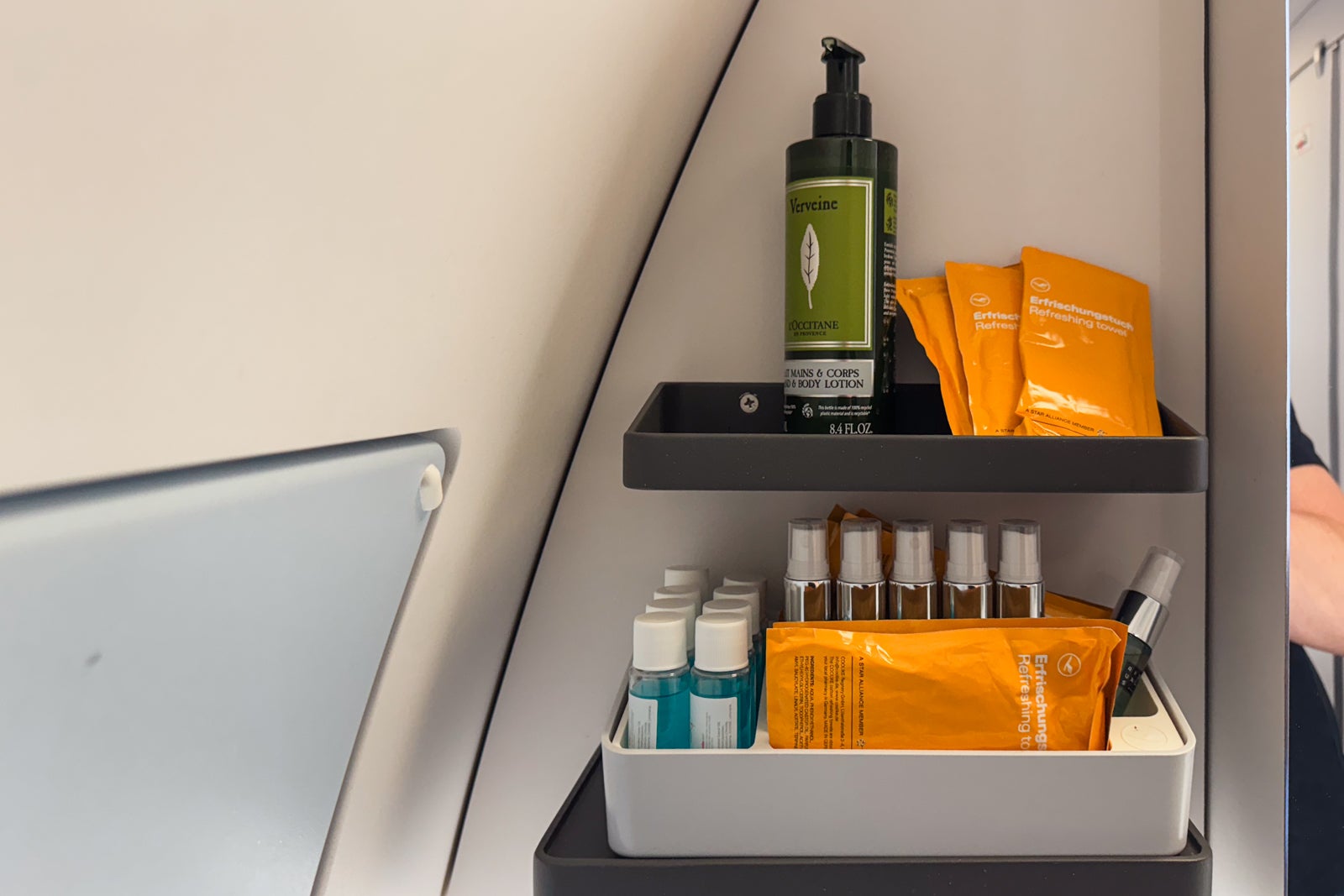
Next slide
1 of 2
ERIC ROSEN/THE POINTS GUY
0
1
The cabin sparkled, a testament to the flight attendants’ tireless care. Forget sterile; this felt like a boutique hotel in the sky. Faux-wood accents whispered luxury, while touchless fixtures in the lavatory hinted at a future of pampering. And then there were the L’Occitane Verveine products a fragrant reminder that even at 30,000 feet, indulgence was on the menu.
Amenities in Lufthansa Allegris business class
Sink into a slumber of vibrant comfort in Lufthansa Allegris business class. Drift off enveloped by a full-size pillow bursting with color, a plush blanket, and a dreamy mattress pad – your personal cloud awaits.
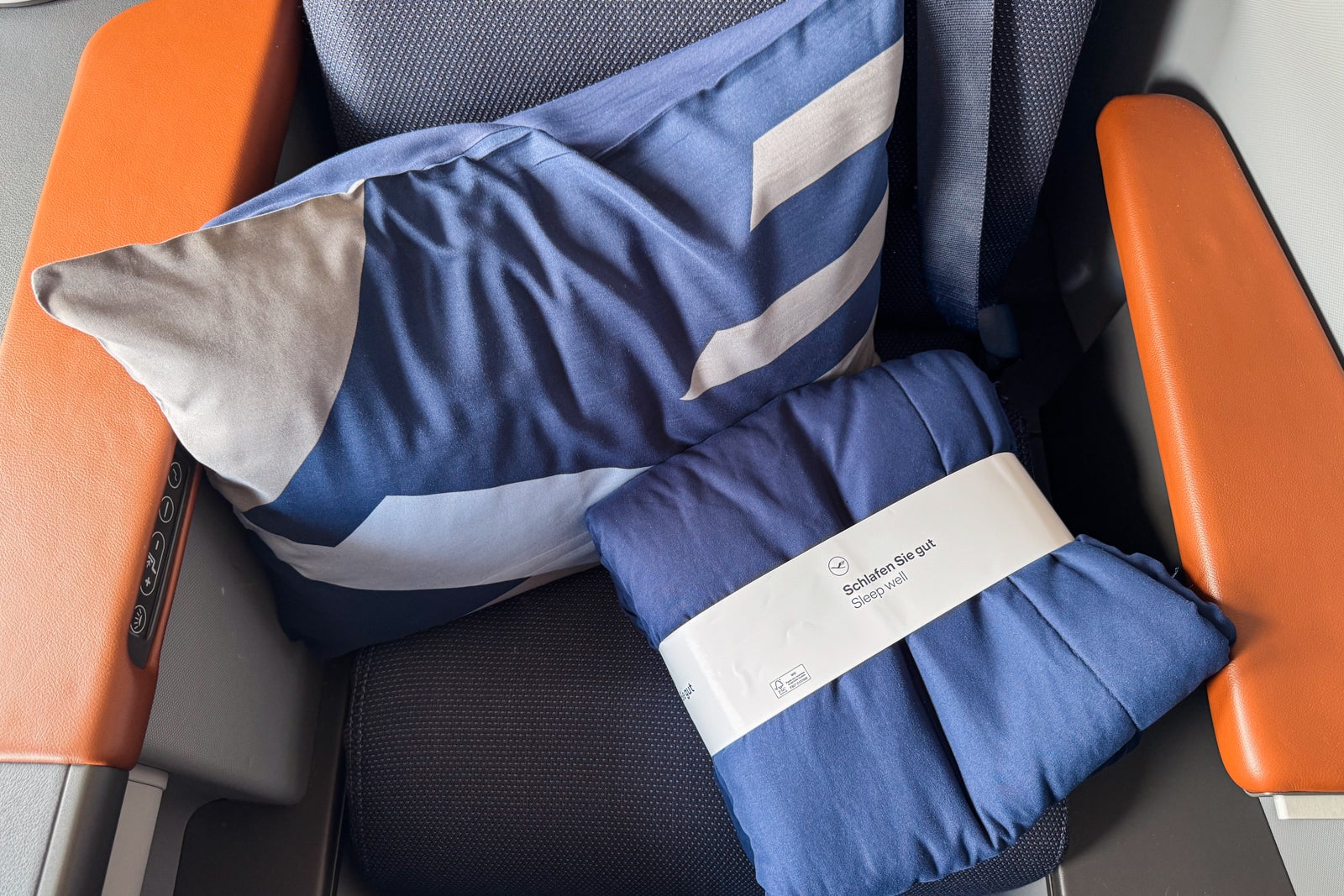
ERIC ROSEN/THE POINTS GUY
I also found a pair of basic noise-canceling headphones waiting in the seat-side cubby for me.
The amenity kit was a cute pouch from Porsche Design with the following:
- Wooden toothbrush and toothpaste
- Eye mask
- Earplugs
- Socks
- Breath mints
- Disposable headphone covers
- Refreshing towel
- L’Occitane Verveine cooling hand gel
- L’Occitane lip balm
The usual amenities were present, but the German-engineered Porsche kit was a delightful surprise. The only disappointment? No pajamas offered on board.
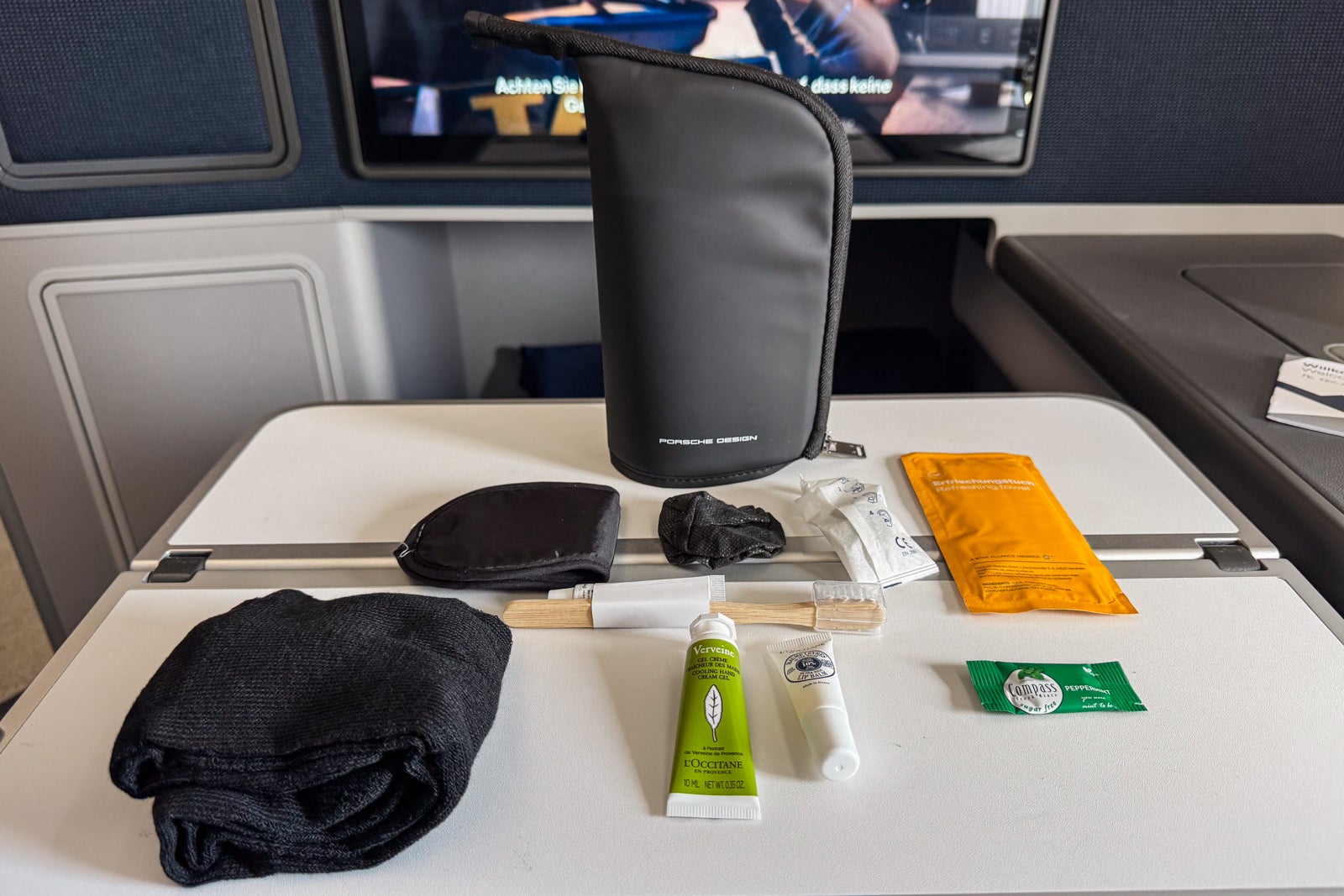
ERIC ROSEN/THE POINTS GUY
Forget fumbling for hidden buttons. The seat controls were cleverly integrated into the side table, which doubled as a Bluetooth hub for your own headphones, instantly transforming your seat into a personalized entertainment zone.
My eyes widened as I settled into my seat; the entertainment screen embedded in the bulkhead was a glorious 24 inches an oasis compared to the postage-stamp-sized screens I’d glimpsed elsewhere. Forget airplane boredom. This wasn’t just a screen; it was a portal. I could sync my own device, diving into my curated world, or explore the in-flight library. Blockbusters like “Anora” and “The Brutalist” beckoned, alongside the comforting familiarity of “30 Rock,” the quirky humor of “Ghosts,” and the rugged drama of “Yellowstone.” Suddenly, the flight wasn’t a journey to endure, but an escape to savor.
Previous slide
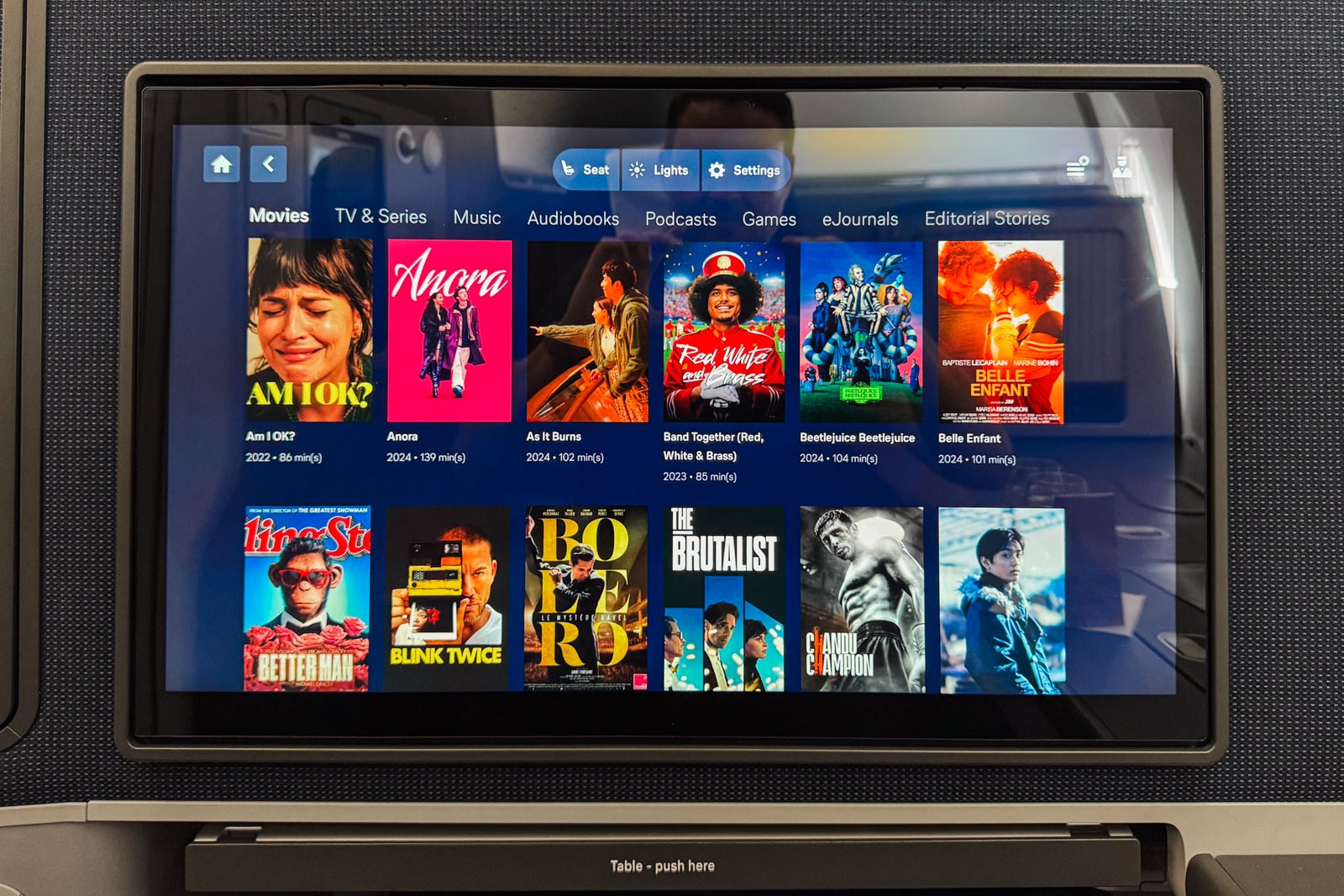
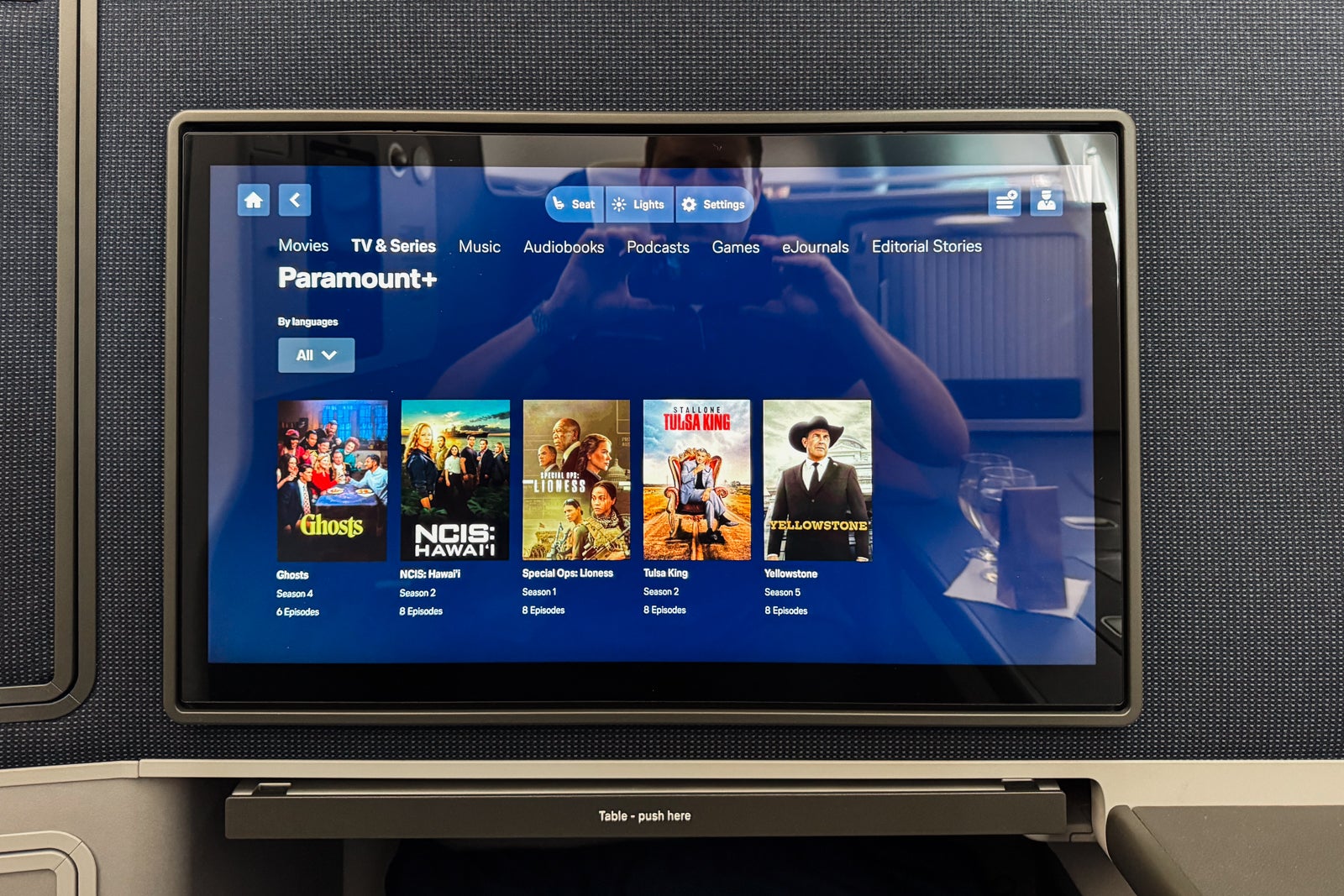
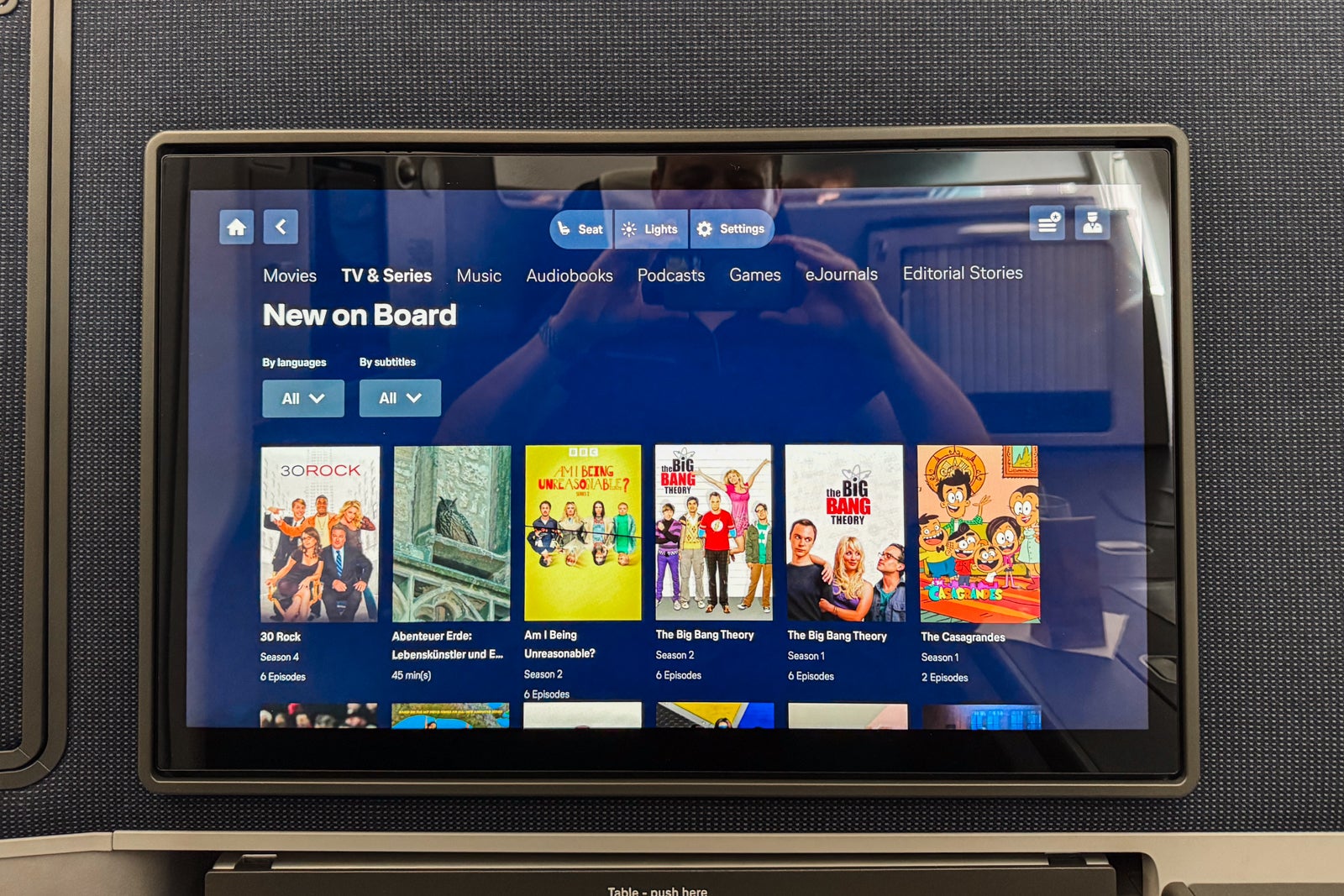
Next slide
1 of 3
ERIC ROSEN/THE POINTS GUY
0
1
2
The touchscreen on the main monitor proved far more responsive than the tablet, banishing the frustrating lag I experienced there. Despite that minor hiccup, the entire system clicked into place with delightful ease.
There were also several Wi-Fi packages available:
- Messaging full-flight (up to 150Kbps): 6 euros ($7)
- Premium for two consecutive hours (up to 4Mbps): 16 euros ($18)
- Premium full-flight (up to 4Mbps): 27 euros ($31)
Previous slide

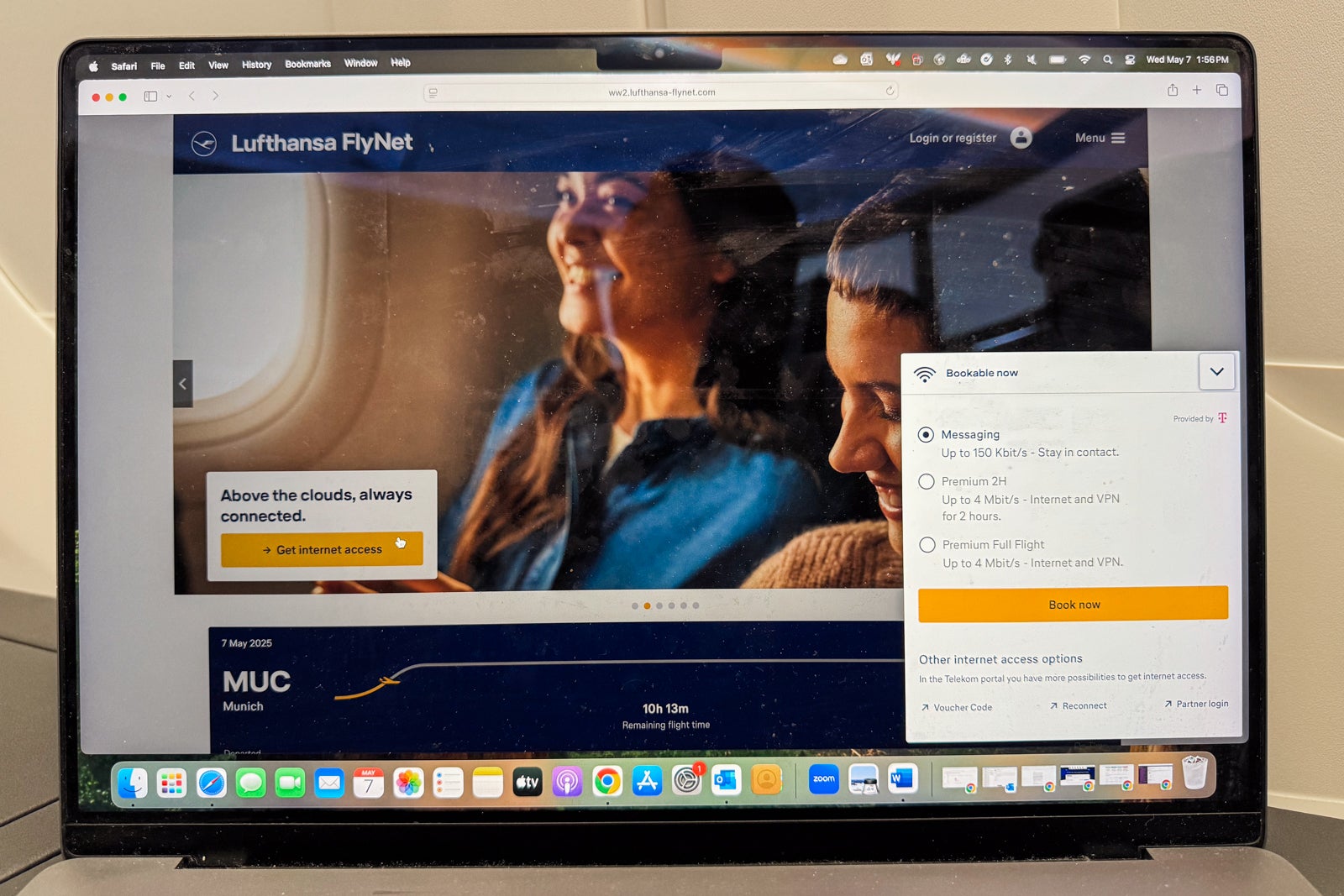
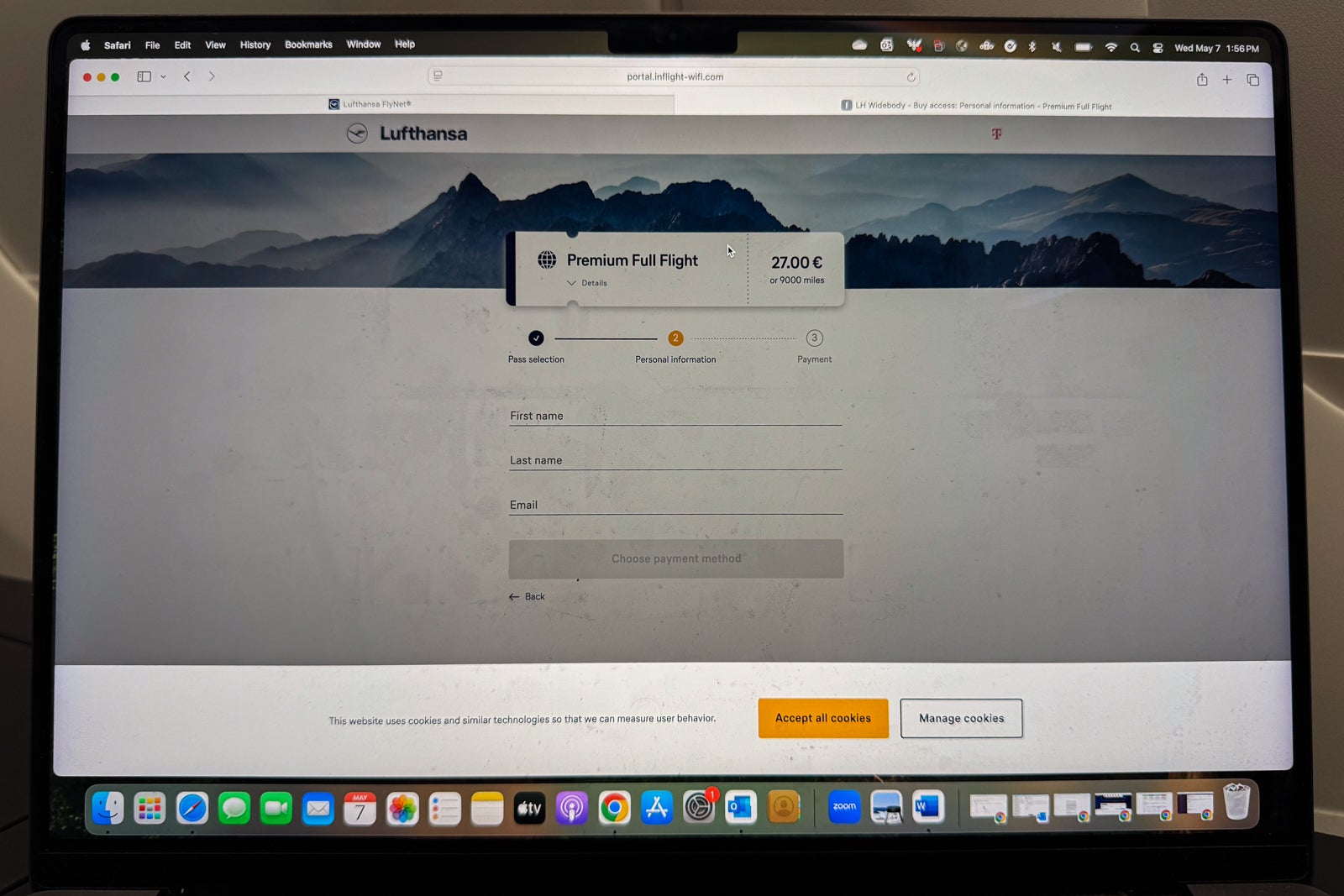
Next slide
1 of 3
ERIC ROSEN/THE POINTS GUY
0
1
2
Opting for the premium, full-flight Wi-Fi package seemed like a savvy move for my daytime flight staying connected was key. While it delivered surprisingly well over terra firma, offering decent connectivity for stretches at a time, don’t bank on it for heavy-duty downloads. My peak speed topped out at a modest 1.1Mbps.

How was the food in Lufthansa Allegris business class?
A week before my Lufthansa long-haul flight, an enticing email landed in my inbox: a sneak peek at the business class menu and the chance to pre-order my main course. Eager to customize my culinary journey, I clicked through, only to be met by a frustrating error message. Defeated but undeterred, I decided to leave my dining destiny to chance and anticipate the in-flight service.
The last passengers hurried aboard, a flurry of late arrivals. Then, a welcome wave: flight attendants gliding through the aisle, offering tiny treasure chests of mixed nuts and a prelude to the journey – cool water, bright orange juice, or a celebratory splash of Sekt. For the more adventurous, there was the Avionic cocktail, a curious concoction promising whispers of peach, a citrusy zing, and the faint, elusive scent of meadow herbs.
Previous slide


Next slide
1 of 2
ERIC ROSEN/THE POINTS GUY
0
1
Twenty minutes into the flight, the cabin crew reappeared, bearing promises of sky-high indulgence. Anticipation crackled as they glided through the aisle, collecting aperitif orders and presenting miniature culinary treasures: ramekins brimming with plump olives, intensely flavored sun-dried tomatoes, and delectable cheese morsels.

ERIC ROSEN/THE POINTS GUY
The beverage choices included:
- Moet & Chandon Imperial Brut Champagne
- Schloss Vollrads riesling from Germany’s Rheingau region
- Escudo Rojo chardonnay from Chile
- Monte Zovo Valpolicella
- Roqueta red wine from Spain
- Chateau d’Arcins red wine from Bordeaux, France
As for beer, you could have:
- Beck’s lager
- Erdinger Weissbier
- Erdinger alcohol-free beer
- Tegernseer Hell pale ale
- Warsteiner Fresh nonalcoholic beer
The drinks selection shimmered: coffee, tea, a rainbow of juices both still and sparkling, and the familiar fizz of Coca-Cola. For something stronger, imagine a crisp gin & tonic with Bombay Sapphire, a smooth vodka martini courtesy of Grey Goose, or the smoky warmth of Jack Daniel’s bourbon. And for the discerning palate, a generous pour of Dewar’s 12-year Scotch awaited.
Business Suite passengers were handed special small menus with additional choices including:
- Pommery Monopole Champagne
- Piper-Heidsieck Blue Top Champagne
- BRLO pale ale
- Hendrick’s gin
- Gin Sui
- Fever-Tree Mediterranean tonic water (compared to just generic tonic water)
- Grape and elderberry spritzes
The first sip of Heidsieck was a revelation a crisp, effervescent prelude that danced on my tongue, awakening my senses in anticipation of the feast to come.
Thirty minutes into the flight, the drink cart vanished, replaced by the tantalizing aroma of dinner. Most passengers lunged for the express lane – a single tray promising a quick return to slumber. But with hours stretching before me like a blank canvas, I decided to savor the full, drawn-out performance of the multi-course meal. Rest and work could wait; this was an experience to be savored.
It began with a choice of starters including:
- Prawn confit with papaya and sweet potato salad, roasted green asparagus and soy mayonnaise
- Marinated veal saddle with bok choy, pineapple jelly, carrot tartare and sesame mayonnaise
- Burrata with tomato, basil and arugula
- “German bread culture” selections including a traditional white bread, mini-baguettes and pumpkin-seed bread
The prawn confit arrived, each delicate morsel glistening like a tiny, amber jewel. Its flavor, a whisper of the sea, danced exquisitely with the crisp acidity of the Riesling. A vibrant, petite salad, kissed with a tangy vinaigrette, offered a refreshing counterpoint to the richness.

ERIC ROSEN/THE POINTS GUY
The choice of main dishes included:
- Salmon with roasted baby potatoes and Szechuan butter
- Dumpling with truffle filling with spicy spinach with riesling cream sauce
- White asparagus with fillet of veal, parsley potatoes and hollandaise
The preorder dishes were also listed and included:
- Pork shoulder with mashed potatoes, horseradish, gravy, carrot and kale with bacon
- Prawns with pumpkin curry sauce, broccoli and sweet potato
- Vegetarian paella with zucchini, mushrooms, broccoli and olives
Veal isn’t usually my thing, but the siren song of white asparagus, at its peak in Germany, was too strong to resist. It felt like a culinary alignment. I took the plunge. Cautious though, I requested the hollandaise on the side, a pale yellow life raft I could abandon if needed. Thankfully, the kitchen obliged, more or less. The veal itself? Succulent. And the asparagus, though yielding slightly more than I’d prefer, burst with the ephemeral taste of the season. A fleeting German spring on a plate.

ERIC ROSEN/THE POINTS GUY
Dessert arrived, a trio of temptations: an artful arrangement of cheeses, a delicate financier promising apricot sunshine and nut-butter earthiness, and a vibrant bowl of fresh fruit. The financier, a siren song of light sweetness, and the pristine fruit proved irresistible.

ERIC ROSEN/THE POINTS GUY
The meal ended, and a four-hour nap claimed me. I awoke to a flight attendant presenting a delightful midflight offering: a warm quiche, savory sausage studded with olive and fig, an artful charcuterie and cheese selection, and a vibrant tomato and artichoke medley with olives.

ERIC ROSEN/THE POINTS GUY
As a Business Suite passenger, I could also choose from a special snack menu that included:
- Keogh’s shamrock and sour cream potato chips
- Mr. Filbert’s French rosemary almonds
- Comte cheese crackers
- Chocolate bites with nuts and fruit
- Chocolate almonds
- Vegan fruit jellies

ERIC ROSEN/THE POINTS GUY
My layover bounty, pilfered packets of pretzels and peanuts, nestled deep in my pockets. I resisted their salty siren song until the in-flight dinner service, roughly an hour and a half before touchdown, when the aroma of airplane cuisine finally trumped my guilt. The choices, alas, were…
- Smoked char with lettuce, curried cream cheese and red radish
- Massaman vegetable curry with jasmine rice and cashews
- Mango mousse with kiwi compote
Craving a dance of flavors, I beckoned the curry – a promise of savory delight, a weightless whisper on the palate. Then, the mango mousse arrived, a flirtatious tango of sweet and tart, a vibrant end to the performance.

ERIC ROSEN/THE POINTS GUY
The meal vanished, and so did I, briefly, back into the cramped airplane lavatory for a quick-change act. Moments later, the captain announced our descent, and the sprawling coastline of San Diego rose to meet us.
Would you recommend Lufthansa Allegris business class?
Lufthansa’s Allegris business class is a huge step forward for the airline, whose older business class was becoming uncompetitive.
Imagine sinking into a cloud, only this cloud is sculpted with Italian leather and boasts more legroom than your living room sofa. That’s the promise of our new seats. We’ve loaded them with the latest tech, a digital playground at your fingertips. Now, about those seat options: think of it as a choose-your-own-adventure in the sky. While the variety is dazzling, the real magic unfolds when you step onboard. Prepare to be amazed.

ERIC ROSEN/THE POINTS GUY
Even if the budget’s tight, those complimentary standard seats are perfectly adequate. But the Business Suite? That’s a whole different experience. Think personal sanctuary: sprawling space, a closing door for ultimate privacy, and delightful perks like a supersized entertainment screen and a curated selection of treats and drinks. It’s less a seat and more a private jet experience for the commercial traveler.
Next time, I’m ditching the premium price tag and diving headfirst into those oh-so-private window seats. A third of the cost for a haven of tranquility? Yes, please!
Forget turbulence; the only thing soaring higher than the plane was the service. The flight attendants weren’t just serving drinks; they were crafting an experience. With a cabin sporting empty seats, they transformed into personal tour guides, demonstrating seat features with genuine enthusiasm. And the snacks and drinks? A constant, welcome presence. My innocent inquiry about the wine list sparked an unexpected generosity – a first-class menu, just for a peek. It was this attentiveness, this willingness to go beyond, that elevated the flight from merely pleasant to genuinely memorable.

ERIC ROSEN/THE POINTS GUY
Hunting for the new Allegris cabin is like searching for a unicorn – tricky, especially when you’re juggling award miles and five unique seat styles. But trust us, spotting this elusive beauty is worth the chase. The experience transcends typical business class; it’s a premium escape. So, if you stumble upon that golden award ticket or a surprisingly affordable fare, seize it. It’s your ticket to a transatlantic flight that feels less like travel and more like a luxurious journey.
Related reading:
- The best airline credit cards
- Premium economy vs. business class: Are the differences worth an upgrade?
- Maximize your airfare: The best credit cards for booking flights
- What are airline alliances, and who’s in them?
- On board the first Lufthansa Allegris flight
Thanks for reading Lufthansa Allegris business class review


